IUPAC NOMENCLATURE for Class 11 CHEMISTRY
INTRODUCTION
Nomenclature implies assigning proper name to a particular organic compound on the basis of certain standard rules so that the study of these compounds may become systematic. In case of aliphatic compounds, two systems of naming are generally used :
(A) Trivial system : In earlier days, the organic compounds were named after the source from which they were obtained. For example, urea got its name because the compound was obtained from the urine of the mammals. Similarly, methyl alcohol was called wood spirit since it could be obtained as one of the products during the destructive distillation of wood. These names are without any systematic basis and are known as common names or trivial names. Such a system of nomenclature is known as trivial system.
(B) IUPAC system : In order to rationalise the system of naming, an International Congress of Chemists was held in Geneva in 1892. They adopted certain uniform rules for naming the compounds. The system of nomenclature was named as Geneva system. Since then the system of naming has been improved from time to time by the International Union of Pure and Applied Chemistry and the new system is called IUPAC system of naming.
INTRODUCTION
Nomenclature implies assigning proper name to a particular organic compound on the basis of certain standard rules so that the study of these compounds may become systematic. In case of aliphatic compounds, two systems of naming are generally used :
(A) Trivial system : In earlier days, the organic compounds were named after the source from which they were obtained. For example, urea got its name because the compound was obtained from the urine of the mammals. Similarly, methyl alcohol was called wood spirit since it could be obtained as one of the products during the destructive distillation of wood. These names are without any systematic basis and are known as common names or trivial names. Such a system of nomenclature is known as trivial system.
(B) IUPAC system : In order to rationalise the system of naming, an International Congress of Chemists was held in Geneva in 1892. They adopted certain uniform rules for naming the compounds. The system of nomenclature was named as Geneva system. Since then the system of naming has been improved from time to time by the International Union of Pure and Applied Chemistry and the new system is called IUPAC system of naming.
INTRODUCTION
Nomenclature implies assigning proper name to a particular organic compound on the basis of certain standard rules so that the study of these compounds may become systematic. In case of aliphatic compounds, two systems of naming are generally used :
(A) Trivial system : In earlier days, the organic compounds were named after the source from which they were obtained. For example, urea got its name because the compound was obtained from the urine of the mammals. Similarly, methyl alcohol was called wood spirit since it could be obtained as one of the products during the destructive distillation of wood. These names are without any systematic basis and are known as common names or trivial names. Such a system of nomenclature is known as trivial system.
(B) IUPAC system : In order to rationalise the system of naming, an International Congress of Chemists was held in Geneva in 1892. They adopted certain uniform rules for naming the compounds. The system of nomenclature was named as Geneva system. Since then the system of naming has been improved from time to time by the International Union of Pure and Applied Chemistry and the new system is called IUPAC system of naming.
INTRODUCTION
Nomenclature implies assigning proper name to a particular organic compound on the basis of certain standard rules so that the study of these compounds may become systematic. In case of aliphatic compounds, two systems of naming are generally used :
(A) Trivial system : In earlier days, the organic compounds were named after the source from which they were obtained. For example, urea got its name because the compound was obtained from the urine of the mammals. Similarly, methyl alcohol was called wood spirit since it could be obtained as one of the products during the destructive distillation of wood. These names are without any systematic basis and are known as common names or trivial names. Such a system of nomenclature is known as trivial system.
(B) IUPAC system : In order to rationalise the system of naming, an International Congress of Chemists was held in Geneva in 1892. They adopted certain uniform rules for naming the compounds. The system of nomenclature was named as Geneva system. Since then the system of naming has been improved from time to time by the International Union of Pure and Applied Chemistry and the new system is called IUPAC system of naming.
Introduction to Organic Compounds
Organic compounds aise compounds hote hai jisme carbon aur hydrogen present hote hai. Organic compounds meh baki elements jaise O,N,S,P bhi present ho sakte hai but carbon aur hydrogen ki presence jaruri hoti hai. Carbon ki self-linking property hoti hai, jisko catenation kaha jata hai aur issi wajah se organic compounds abundance meh milte hai. Kafi sare organic compounds nature meh already exist karte hai aur har saal new organic compounds bhi synthesize hote hai.

Bond energy following factors par depend karti hai :
(i) Atomic size (Inversely proportional)
Size :
(ii) Electronegativity difference along period (Directly Proportional)
E.N Difference :
(iii) Bond order i.e no. of covalent bonds between atoms (Directly Proportional)
Bond Order :
Catenation in Carbon
Carbon element ki catenation or self linkage show karne ki tendency strongest hoti hai. Aisa following reasons ki wajah se hota hai :
(i) Carbon tetravalent hai isliye ye apne sath aur bahut sare other elements ke sath σ bonds bana leta hai.
(ii) Carbon multiple bonds (C=C,C≡C) form kar sakta hai. Aisa isliye hota hai kyunki iska small size hota hai jis ki wajah se p−orbitals ke beech meh efficient collateral overlapping hoti hai aur aisi overlapping only carbon meh hi possible hoti hai.
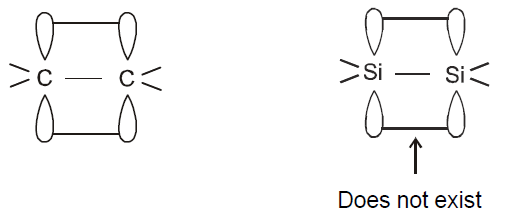
(iii) C−C bond ki bond energy kafi high hoti hai iss wajah se carbon long chains aur cyclic compounds meh bhi strong bonds bana leta hai.
Hybridisation of Carbon
Carbon 3 types ki hybridisation show karta hai aur yeh hai − sp,sp2,sp3. Kisi bhi structure ki hybridisation state nikalne ke liye hum uss structure ke carbon atom ke around sigma bond calculate karte hai. Therefore :
(i) 4 σ bonds around carbon − sp3 hybridisation
(ii) 3 σ bonds around carbon − sp2 hybridisation
(iii) 2 σ bonds around carbon − sp hybridisation
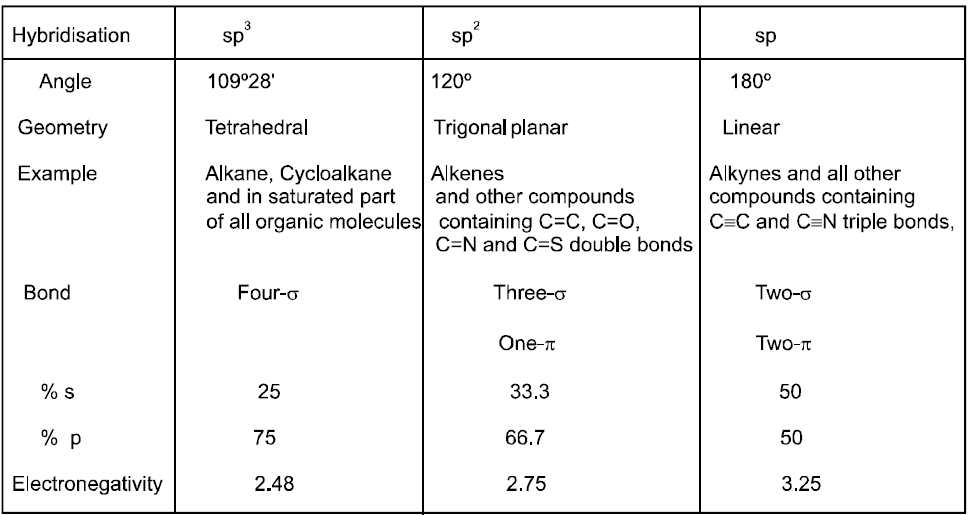
Few informations regarding these orbitals are summarised as :
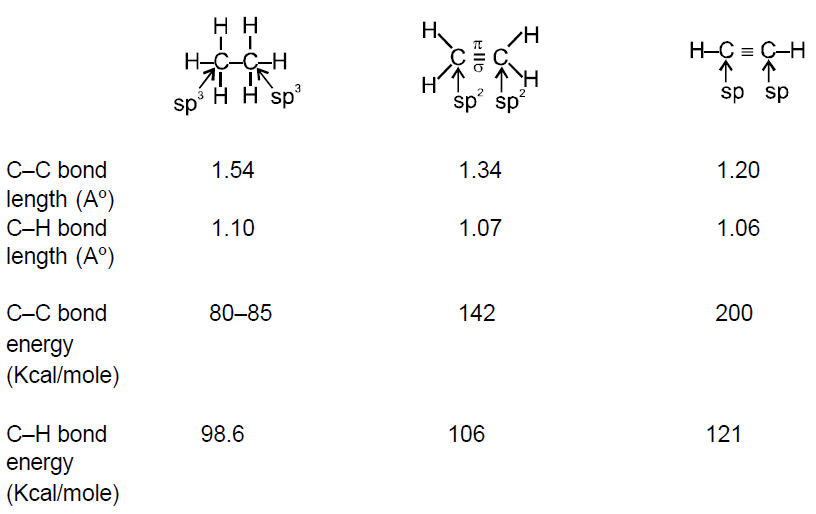
Carbon − carbon π bond meh sideways overlapping kam hoti hai aur isliye ye bond σ bond se hamesha weaker hota hai. However, C=C double bond meh ek σ bond aur ek π bond present hota hai jis wajah se ye C−C single bond se stronger hota hai. Similarly, C≡C triple bond stronger hota hai in comparison to C=C double bond.
Introduction to Organic Compounds
Organic compounds aise compounds hote hai jisme carbon aur hydrogen present hote hai. Organic compounds meh baki elements jaise O,N,S,P bhi present ho sakte hai but carbon aur hydrogen ki presence jaruri hoti hai. Carbon ki self-linking property hoti hai, jisko catenation kaha jata hai aur issi wajah se organic compounds abundance meh milte hai. Kafi sare organic compounds nature meh already exist karte hai aur har saal new organic compounds bhi synthesize hote hai.

Bond energy following factors par depend karti hai :
(i) Atomic size (Inversely proportional)
Size :
(ii) Electronegativity difference along period (Directly Proportional)
E.N Difference :
(iii) Bond order i.e no. of covalent bonds between atoms (Directly Proportional)
Bond Order :
Catenation in Carbon
Carbon element ki catenation or self linkage show karne ki tendency strongest hoti hai. Aisa following reasons ki wajah se hota hai :
(i) Carbon tetravalent hai isliye ye apne sath aur bahut sare other elements ke sath σ bonds bana leta hai.
(ii) Carbon multiple bonds (C=C,C≡C) form kar sakta hai. Aisa isliye hota hai kyunki iska small size hota hai jis ki wajah se p−orbitals ke beech meh efficient collateral overlapping hoti hai aur aisi overlapping only carbon meh hi possible hoti hai.

(iii) C−C bond ki bond energy kafi high hoti hai iss wajah se carbon long chains aur cyclic compounds meh bhi strong bonds bana leta hai.
Hybridisation of Carbon
Carbon 3 types ki hybridisation show karta hai aur yeh hai − sp,sp2,sp3. Kisi bhi structure ki hybridisation state nikalne ke liye hum uss structure ke carbon atom ke around sigma bond calculate karte hai. Therefore :
(i) 4 σ bonds around carbon − sp3 hybridisation
(ii) 3 σ bonds around carbon − sp2 hybridisation
(iii) 2 σ bonds around carbon − sp hybridisation

Few informations regarding these orbitals are summarised as :

Carbon − carbon π bond meh sideways overlapping kam hoti hai aur isliye ye bond σ bond se hamesha weaker hota hai. However, C=C double bond meh ek σ bond aur ek π bond present hota hai jis wajah se ye C−C single bond se stronger hota hai. Similarly, C≡C triple bond stronger hota hai in comparison to C=C double bond.
Introduction to Organic Compounds
Organic compounds aise compounds hote hai jisme carbon aur hydrogen present hote hai. Organic compounds meh baki elements jaise O,N,S,P bhi present ho sakte hai but carbon aur hydrogen ki presence jaruri hoti hai. Carbon ki self-linking property hoti hai, jisko catenation kaha jata hai aur issi wajah se organic compounds abundance meh milte hai. Kafi sare organic compounds nature meh already exist karte hai aur har saal new organic compounds bhi synthesize hote hai.

Bond energy following factors par depend karti hai :
(i) Atomic size (Inversely proportional)
Size :
(ii) Electronegativity difference along period (Directly Proportional)
E.N Difference :
(iii) Bond order i.e no. of covalent bonds between atoms (Directly Proportional)
Bond Order :
Catenation in Carbon
Carbon element ki catenation or self linkage show karne ki tendency strongest hoti hai. Aisa following reasons ki wajah se hota hai :
(i) Carbon tetravalent hai isliye ye apne sath aur bahut sare other elements ke sath σ bonds bana leta hai.
(ii) Carbon multiple bonds (C=C,C≡C) form kar sakta hai. Aisa isliye hota hai kyunki iska small size hota hai jis ki wajah se p−orbitals ke beech meh efficient collateral overlapping hoti hai aur aisi overlapping only carbon meh hi possible hoti hai.

(iii) C−C bond ki bond energy kafi high hoti hai iss wajah se carbon long chains aur cyclic compounds meh bhi strong bonds bana leta hai.
Hybridisation of Carbon
Carbon 3 types ki hybridisation show karta hai aur yeh hai − sp,sp2,sp3. Kisi bhi structure ki hybridisation state nikalne ke liye hum uss structure ke carbon atom ke around sigma bond calculate karte hai. Therefore :
(i) 4 σ bonds around carbon − sp3 hybridisation
(ii) 3 σ bonds around carbon − sp2 hybridisation
(iii) 2 σ bonds around carbon − sp hybridisation

Few informations regarding these orbitals are summarised as :

Carbon − carbon π bond meh sideways overlapping kam hoti hai aur isliye ye bond σ bond se hamesha weaker hota hai. However, C=C double bond meh ek σ bond aur ek π bond present hota hai jis wajah se ye C−C single bond se stronger hota hai. Similarly, C≡C triple bond stronger hota hai in comparison to C=C double bond.
Introduction to Organic Compounds
Organic compounds aise compounds hote hai jisme carbon aur hydrogen present hote hai. Organic compounds meh baki elements jaise O,N,S,P bhi present ho sakte hai but carbon aur hydrogen ki presence jaruri hoti hai. Carbon ki self-linking property hoti hai, jisko catenation kaha jata hai aur issi wajah se organic compounds abundance meh milte hai. Kafi sare organic compounds nature meh already exist karte hai aur har saal new organic compounds bhi synthesize hote hai.

Bond energy following factors par depend karti hai :
(i) Atomic size (Inversely proportional)
Size :
(ii) Electronegativity difference along period (Directly Proportional)
E.N Difference :
(iii) Bond order i.e no. of covalent bonds between atoms (Directly Proportional)
Bond Order :
Catenation in Carbon
Carbon element ki catenation or self linkage show karne ki tendency strongest hoti hai. Aisa following reasons ki wajah se hota hai :
(i) Carbon tetravalent hai isliye ye apne sath aur bahut sare other elements ke sath σ bonds bana leta hai.
(ii) Carbon multiple bonds (C=C,C≡C) form kar sakta hai. Aisa isliye hota hai kyunki iska small size hota hai jis ki wajah se p−orbitals ke beech meh efficient collateral overlapping hoti hai aur aisi overlapping only carbon meh hi possible hoti hai.

(iii) C−C bond ki bond energy kafi high hoti hai iss wajah se carbon long chains aur cyclic compounds meh bhi strong bonds bana leta hai.
Hybridisation of Carbon
Carbon 3 types ki hybridisation show karta hai aur yeh hai − sp,sp2,sp3. Kisi bhi structure ki hybridisation state nikalne ke liye hum uss structure ke carbon atom ke around sigma bond calculate karte hai. Therefore :
(i) 4 σ bonds around carbon − sp3 hybridisation
(ii) 3 σ bonds around carbon − sp2 hybridisation
(iii) 2 σ bonds around carbon − sp hybridisation

Few informations regarding these orbitals are summarised as :

Carbon − carbon π bond meh sideways overlapping kam hoti hai aur isliye ye bond σ bond se hamesha weaker hota hai. However, C=C double bond meh ek σ bond aur ek π bond present hota hai jis wajah se ye C−C single bond se stronger hota hai. Similarly, C≡C triple bond stronger hota hai in comparison to C=C double bond.
Introduction to Organic Compounds
Organic compounds are compounds of carbon and hydrogen and the following elements may also be present : (Halogens, N,S,P,O). There are a large number of organic compounds available and a large number of organic compounds are synthesized every year. The most important reason for the large number of organic compounds is the property of catenation (self—linkage) in carbon.

Bond energy depends on :
(i) Size of an Atom (inversely proportional) :
Size :
(ii) Electronegativity difference along period (Directly Proportional) :
E.N. Difference :
(iii) Bond order i.e no. of covalent bonds between atoms (Directly Proportional) :
Bond Order :
Catenation in Carbon
The element carbon has strongest tendency to show catenation or self—linkage due to :
(a) It’s tetravalency so that it can form σ bonds with many elements as well as carbon itself.
(b) It can form multiple bonds (C=C,C≡C). Due to its small size, there is efficient collateral overlapping between two p—orbitals.

(c) High bond energy of C−C bond so that it can form strong bonds in long chains and in cyclic compounds.
Hybridisation of Carbon
It is of three types and these are sp3,sp2andsp. These hybridised states in any given structure can be known by counting σ bonds around the carbon atoms as σ bonds are formed by hybrid orbitals. Thus,
(i) 4 σ bonds around carbon − sp3 hybridisation
(ii) 3 σ bonds around carbon − sp2 hybridisation
(iii) 2 σ bonds around carbon − sp hybridisation

Few informations regarding these orbitals are summarised as :

Since the extent of overlap in sideways overlap is low, a carbon − carbon π bond is always weaker than a carbon − carbon σ bond. A carbon − carbon double bond is, however, stronger than a carbon − carbon single bond since it consists of a σ bond and a weak π bond. In a similar way, a carbon − carbon triple bond is stronger than carbon − carbon double bond.
Introduction to Organic Compounds
Organic compounds are compounds of carbon and hydrogen and the following elements may also be present : (Halogens, N,S,P,O). There are a large number of organic compounds available and a large number of organic compounds are synthesized every year. The most important reason for the large number of organic compounds is the property of catenation (self—linkage) in carbon.

Bond energy depends on :
(i) Size of an Atom (inversely proportional) :
Size :
(ii) Electronegativity difference along period (Directly Proportional) :
E.N. Difference :
(iii) Bond order i.e no. of covalent bonds between atoms (Directly Proportional) :
Bond Order :
Catenation in Carbon
The element carbon has strongest tendency to show catenation or self—linkage due to :
(a) It’s tetravalency so that it can form σ bonds with many elements as well as carbon itself.
(b) It can form multiple bonds (C=C,C≡C). Due to its small size, there is efficient collateral overlapping between two p—orbitals.

(c) High bond energy of C−C bond so that it can form strong bonds in long chains and in cyclic compounds.
Hybridisation of Carbon
It is of three types and these are sp3,sp2andsp. These hybridised states in any given structure can be known by counting σ bonds around the carbon atoms as σ bonds are formed by hybrid orbitals. Thus,
(i) 4 σ bonds around carbon − sp3 hybridisation
(ii) 3 σ bonds around carbon − sp2 hybridisation
(iii) 2 σ bonds around carbon − sp hybridisation

Few informations regarding these orbitals are summarised as :

Since the extent of overlap in sideways overlap is low, a carbon − carbon π bond is always weaker than a carbon − carbon σ bond. A carbon − carbon double bond is, however, stronger than a carbon − carbon single bond since it consists of a σ bond and a weak π bond. In a similar way, a carbon − carbon triple bond is stronger than carbon − carbon double bond.
Introduction to Organic Compounds
Organic compounds are compounds of carbon and hydrogen and the following elements may also be present : (Halogens, N,S,P,O). There are a large number of organic compounds available and a large number of organic compounds are synthesized every year. The most important reason for the large number of organic compounds is the property of catenation (self—linkage) in carbon.

Bond energy depends on :
(i) Size of an Atom (inversely proportional) :
Size :
(ii) Electronegativity difference along period (Directly Proportional) :
E.N. Difference :
(iii) Bond order i.e no. of covalent bonds between atoms (Directly Proportional) :
Bond Order :
Catenation in Carbon
The element carbon has strongest tendency to show catenation or self—linkage due to :
(a) It’s tetravalency so that it can form σ bonds with many elements as well as carbon itself.
(b) It can form multiple bonds (C=C,C≡C). Due to its small size, there is efficient collateral overlapping between two p—orbitals.

(c) High bond energy of C−C bond so that it can form strong bonds in long chains and in cyclic compounds.
Hybridisation of Carbon
It is of three types and these are sp3,sp2andsp. These hybridised states in any given structure can be known by counting σ bonds around the carbon atoms as σ bonds are formed by hybrid orbitals. Thus,
(i) 4 σ bonds around carbon − sp3 hybridisation
(ii) 3 σ bonds around carbon − sp2 hybridisation
(iii) 2 σ bonds around carbon − sp hybridisation

Few informations regarding these orbitals are summarised as :

Since the extent of overlap in sideways overlap is low, a carbon − carbon π bond is always weaker than a carbon − carbon σ bond. A carbon − carbon double bond is, however, stronger than a carbon − carbon single bond since it consists of a σ bond and a weak π bond. In a similar way, a carbon − carbon triple bond is stronger than carbon − carbon double bond.
Introduction to Organic Compounds
Organic compounds are compounds of carbon and hydrogen and the following elements may also be present : (Halogens, N,S,P,O). There are a large number of organic compounds available and a large number of organic compounds are synthesized every year. The most important reason for the large number of organic compounds is the property of catenation (self—linkage) in carbon.

Bond energy depends on :
(i) Size of an Atom (inversely proportional) :
Size :
(ii) Electronegativity difference along period (Directly Proportional) :
E.N. Difference :
(iii) Bond order i.e no. of covalent bonds between atoms (Directly Proportional) :
Bond Order :
Catenation in Carbon
The element carbon has strongest tendency to show catenation or self—linkage due to :
(a) It’s tetravalency so that it can form σ bonds with many elements as well as carbon itself.
(b) It can form multiple bonds (C=C,C≡C). Due to its small size, there is efficient collateral overlapping between two p—orbitals.

(c) High bond energy of C−C bond so that it can form strong bonds in long chains and in cyclic compounds.
Hybridisation of Carbon
It is of three types and these are sp3,sp2andsp. These hybridised states in any given structure can be known by counting σ bonds around the carbon atoms as σ bonds are formed by hybrid orbitals. Thus,
(i) 4 σ bonds around carbon − sp3 hybridisation
(ii) 3 σ bonds around carbon − sp2 hybridisation
(iii) 2 σ bonds around carbon − sp hybridisation

Few informations regarding these orbitals are summarised as :

Since the extent of overlap in sideways overlap is low, a carbon − carbon π bond is always weaker than a carbon − carbon σ bond. A carbon − carbon double bond is, however, stronger than a carbon − carbon single bond since it consists of a σ bond and a weak π bond. In a similar way, a carbon − carbon triple bond is stronger than carbon − carbon double bond.
Important Terms
Saturated Compounds :
Jab ek element ki sabhi valencies σ covalent bonds se satisfied ho jati hai toh wo saturated compounds hote hai.
Unsaturated Compounds :
Jab kisi compound meh ek ya ek se jayda π bonds presence hote hai (C=C,N=N,C=N,C=O or C≡C,N≡N,C≡N) toh wo unsaturated compounds hote hai.
Molecular Formula :
Molecular formula kisi bhi compound ke ek molecule meh present elements ke actual number of atoms ko indicate karta hai.
Structural Formula :
Ye kisi molecule meh present different atoms ki linkage jo covalent bonds ke through hoti hai usko indicate karta hai.
(i) Expanded Structural Formula (E.S.F)
(ii) Condensed Structural Formula (C.S.F)
(iii) Bondline Structural Formula (B.S.F)
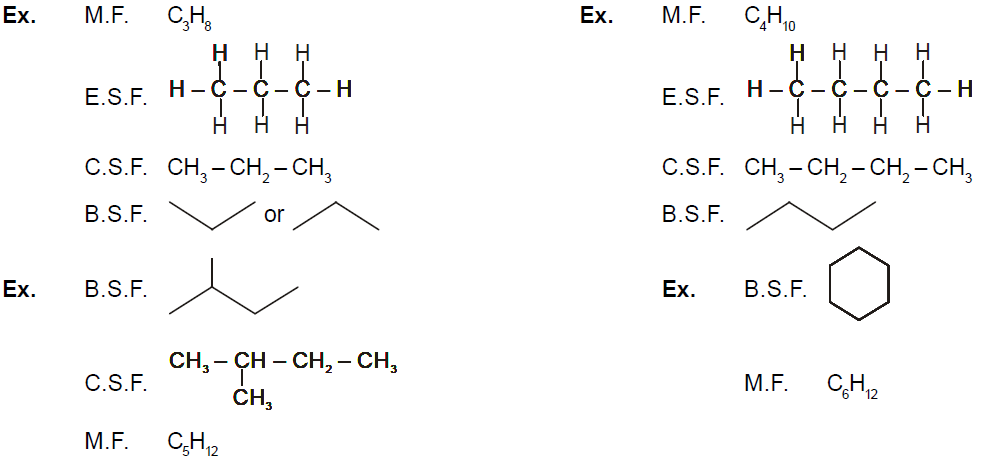
Homologous Series :
Ye similarly constituted compounds ki ek series hoti hai jahan sare members same functional group aur similar chemical characteristics possess karte hai. Homologous series ke members ka molecular formula −CH2 se differ karta hai aur inki physical properties meh bhi regular gradation hota hai.
Degree of Carbon :
Ek carbon se attached no. of carbon atoms ko degree of carbon kaha jata hai.
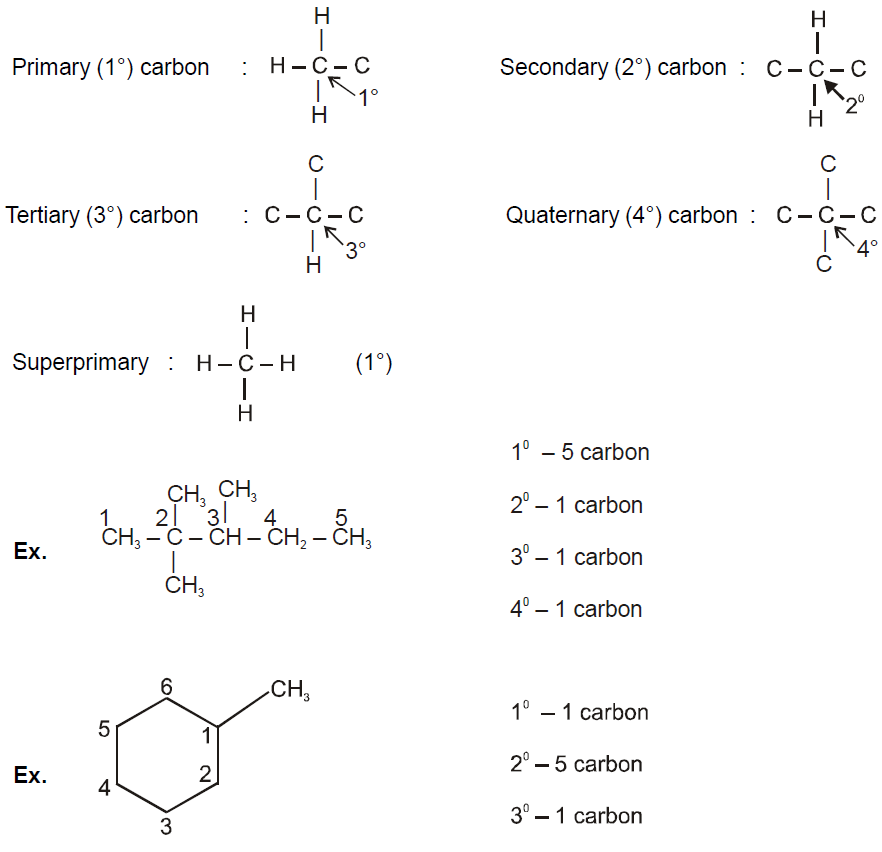
Degree of Hydrogen :
Degree of hydrogen bhi attached carbon ki degree ke equal hoti hai. Ye ek saturated hydrocarbon meh type of C−C bonds aur type of replaceable H atoms indicate karta hai.
Note : Total no. of monosubstituted products replaceable H−atoms ke types par depend karta hai and not on type of C−atoms.
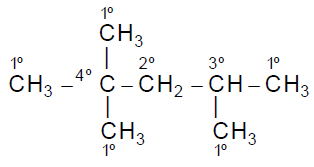
Important Terms
Saturated Compounds :
Jab ek element ki sabhi valencies σ covalent bonds se satisfied ho jati hai toh wo saturated compounds hote hai.
Unsaturated Compounds :
Jab kisi compound meh ek ya ek se jayda π bonds presence hote hai (C=C,N=N,C=N,C=O or C≡C,N≡N,C≡N) toh wo unsaturated compounds hote hai.
Molecular Formula :
Molecular formula kisi bhi compound ke ek molecule meh present elements ke actual number of atoms ko indicate karta hai.
Structural Formula :
Ye kisi molecule meh present different atoms ki linkage jo covalent bonds ke through hoti hai usko indicate karta hai.
(i) Expanded Structural Formula (E.S.F)
(ii) Condensed Structural Formula (C.S.F)
(iii) Bondline Structural Formula (B.S.F)

Homologous Series :
Ye similarly constituted compounds ki ek series hoti hai jahan sare members same functional group aur similar chemical characteristics possess karte hai. Homologous series ke members ka molecular formula −CH2 se differ karta hai aur inki physical properties meh bhi regular gradation hota hai.
Degree of Carbon :
Ek carbon se attached no. of carbon atoms ko degree of carbon kaha jata hai.

Degree of Hydrogen :
Degree of hydrogen bhi attached carbon ki degree ke equal hoti hai. Ye ek saturated hydrocarbon meh type of C−C bonds aur type of replaceable H atoms indicate karta hai.
Note : Total no. of monosubstituted products replaceable H−atoms ke types par depend karta hai and not on type of C−atoms.

Important Terms
Saturated Compounds :
Jab ek element ki sabhi valencies σ covalent bonds se satisfied ho jati hai toh wo saturated compounds hote hai.
Unsaturated Compounds :
Jab kisi compound meh ek ya ek se jayda π bonds presence hote hai (C=C,N=N,C=N,C=O or C≡C,N≡N,C≡N) toh wo unsaturated compounds hote hai.
Molecular Formula :
Molecular formula kisi bhi compound ke ek molecule meh present elements ke actual number of atoms ko indicate karta hai.
Structural Formula :
Ye kisi molecule meh present different atoms ki linkage jo covalent bonds ke through hoti hai usko indicate karta hai.
(i) Expanded Structural Formula (E.S.F)
(ii) Condensed Structural Formula (C.S.F)
(iii) Bondline Structural Formula (B.S.F)

Homologous Series :
Ye similarly constituted compounds ki ek series hoti hai jahan sare members same functional group aur similar chemical characteristics possess karte hai. Homologous series ke members ka molecular formula −CH2 se differ karta hai aur inki physical properties meh bhi regular gradation hota hai.
Degree of Carbon :
Ek carbon se attached no. of carbon atoms ko degree of carbon kaha jata hai.

Degree of Hydrogen :
Degree of hydrogen bhi attached carbon ki degree ke equal hoti hai. Ye ek saturated hydrocarbon meh type of C−C bonds aur type of replaceable H atoms indicate karta hai.
Note : Total no. of monosubstituted products replaceable H−atoms ke types par depend karta hai and not on type of C−atoms.

Important Terms
Saturated Compounds :
Jab ek element ki sabhi valencies σ covalent bonds se satisfied ho jati hai toh wo saturated compounds hote hai.
Unsaturated Compounds :
Jab kisi compound meh ek ya ek se jayda π bonds presence hote hai (C=C,N=N,C=N,C=O or C≡C,N≡N,C≡N) toh wo unsaturated compounds hote hai.
Molecular Formula :
Molecular formula kisi bhi compound ke ek molecule meh present elements ke actual number of atoms ko indicate karta hai.
Structural Formula :
Ye kisi molecule meh present different atoms ki linkage jo covalent bonds ke through hoti hai usko indicate karta hai.
(i) Expanded Structural Formula (E.S.F)
(ii) Condensed Structural Formula (C.S.F)
(iii) Bondline Structural Formula (B.S.F)

Homologous Series :
Ye similarly constituted compounds ki ek series hoti hai jahan sare members same functional group aur similar chemical characteristics possess karte hai. Homologous series ke members ka molecular formula −CH2 se differ karta hai aur inki physical properties meh bhi regular gradation hota hai.
Degree of Carbon :
Ek carbon se attached no. of carbon atoms ko degree of carbon kaha jata hai.

Degree of Hydrogen :
Degree of hydrogen bhi attached carbon ki degree ke equal hoti hai. Ye ek saturated hydrocarbon meh type of C−C bonds aur type of replaceable H atoms indicate karta hai.
Note : Total no. of monosubstituted products replaceable H−atoms ke types par depend karta hai and not on type of C−atoms.

Important Terms
Saturated Compounds :
When all the valencies of an element are satisfied by σ covalent bonds.
Unsaturated Compounds :
When a compound contains one or more π bonds (C=C,N=N,C=N,C=O or C≡C,N≡N,C≡N).
Molecular Formula :
The molecular formula of a compound indicates the actual number of atoms of each element present in one molecule.
Structural Formula :
It indicates the linkage due to covalent bond between different atoms in a molecule.
(i) Expanded Structural Formula (E.S.F)
(ii) Condensed Structural Formula (C.S.F)
(iii) Bondline Structural Formula (B.S.F)

Homologous Series :
Homologous series may be defined as a series of similarly constituted compounds in which the members possess the same functional group, have similar chemical characteristics and have a regular gradation in their physical properties. The two consecutive members differ in their molecular formula by −CH2.
Degree of Carbon :
It is defined as the number of carbon atoms attached to a carbon atom.

Degree of Hydrogen :
Degree of hydrogen is the same as the degree of carbon to which it is attached.
This indicates the type of C−C bonds and type of replaceable H atoms in saturated hydrocarbon.
Note : Total no. of monosubstituted product does not depend upon type of C−atoms but depends upon type of replaceable H−atoms.

Important Terms
Saturated Compounds :
When all the valencies of an element are satisfied by σ covalent bonds.
Unsaturated Compounds :
When a compound contains one or more π bonds (C=C,N=N,C=N,C=O or C≡C,N≡N,C≡N).
Molecular Formula :
The molecular formula of a compound indicates the actual number of atoms of each element present in one molecule.
Structural Formula :
It indicates the linkage due to covalent bond between different atoms in a molecule.
(i) Expanded Structural Formula (E.S.F)
(ii) Condensed Structural Formula (C.S.F)
(iii) Bondline Structural Formula (B.S.F)

Homologous Series :
Homologous series may be defined as a series of similarly constituted compounds in which the members possess the same functional group, have similar chemical characteristics and have a regular gradation in their physical properties. The two consecutive members differ in their molecular formula by −CH2.
Degree of Carbon :
It is defined as the number of carbon atoms attached to a carbon atom.

Degree of Hydrogen :
Degree of hydrogen is the same as the degree of carbon to which it is attached.
This indicates the type of C−C bonds and type of replaceable H atoms in saturated hydrocarbon.
Note : Total no. of monosubstituted product does not depend upon type of C−atoms but depends upon type of replaceable H−atoms.

Important Terms
Saturated Compounds :
When all the valencies of an element are satisfied by σ covalent bonds.
Unsaturated Compounds :
When a compound contains one or more π bonds (C=C,N=N,C=N,C=O or C≡C,N≡N,C≡N).
Molecular Formula :
The molecular formula of a compound indicates the actual number of atoms of each element present in one molecule.
Structural Formula :
It indicates the linkage due to covalent bond between different atoms in a molecule.
(i) Expanded Structural Formula (E.S.F)
(ii) Condensed Structural Formula (C.S.F)
(iii) Bondline Structural Formula (B.S.F)

Homologous Series :
Homologous series may be defined as a series of similarly constituted compounds in which the members possess the same functional group, have similar chemical characteristics and have a regular gradation in their physical properties. The two consecutive members differ in their molecular formula by −CH2.
Degree of Carbon :
It is defined as the number of carbon atoms attached to a carbon atom.

Degree of Hydrogen :
Degree of hydrogen is the same as the degree of carbon to which it is attached.
This indicates the type of C−C bonds and type of replaceable H atoms in saturated hydrocarbon.
Note : Total no. of monosubstituted product does not depend upon type of C−atoms but depends upon type of replaceable H−atoms.

Important Terms
Saturated Compounds :
When all the valencies of an element are satisfied by σ covalent bonds.
Unsaturated Compounds :
When a compound contains one or more π bonds (C=C,N=N,C=N,C=O or C≡C,N≡N,C≡N).
Molecular Formula :
The molecular formula of a compound indicates the actual number of atoms of each element present in one molecule.
Structural Formula :
It indicates the linkage due to covalent bond between different atoms in a molecule.
(i) Expanded Structural Formula (E.S.F)
(ii) Condensed Structural Formula (C.S.F)
(iii) Bondline Structural Formula (B.S.F)

Homologous Series :
Homologous series may be defined as a series of similarly constituted compounds in which the members possess the same functional group, have similar chemical characteristics and have a regular gradation in their physical properties. The two consecutive members differ in their molecular formula by −CH2.
Degree of Carbon :
It is defined as the number of carbon atoms attached to a carbon atom.

Degree of Hydrogen :
Degree of hydrogen is the same as the degree of carbon to which it is attached.
This indicates the type of C−C bonds and type of replaceable H atoms in saturated hydrocarbon.
Note : Total no. of monosubstituted product does not depend upon type of C−atoms but depends upon type of replaceable H−atoms.

Classification of Organic Compounds
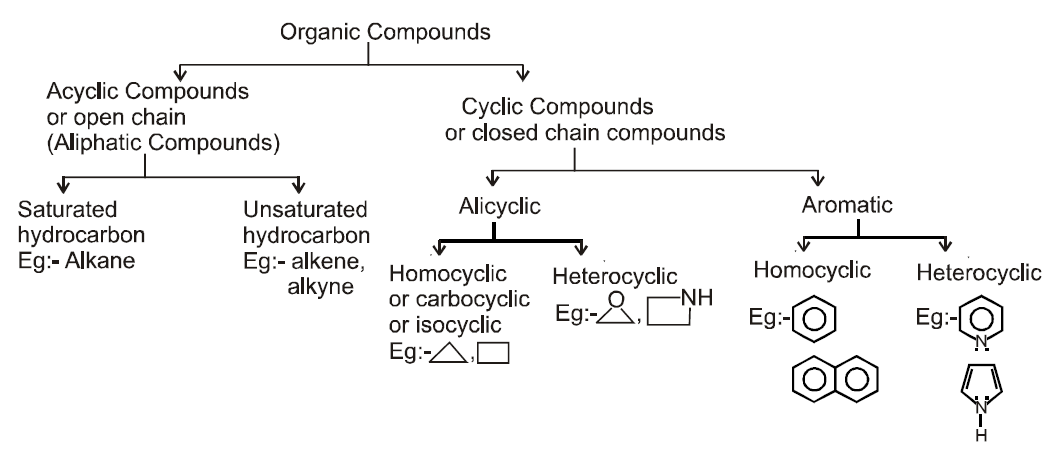
Some of the examples with their classsifications are discussed below :

Aromatic Compound [The Huckel (4n+2)π Rule] :
In order to predict ki particular compound aromatic hai ya nahi, uske liye hum following three rules use karte hai :
1) Aromatic compounds humesha cyclic or planar hote hai.
2) Har ek carbon atom aromatic ring meh sp2 ya sp hybridised hota hai aur ye close conjugation bhi possess karta hai.
3) p−orbitals ki overlap se bane cyclic π molecular orbital meh hamesha (4n+2)π (i.e 2,6,10,14….etc) electrons hote hai yahan par n= integer (0,1,2,3….) hota hai.
Non-Benzenoid Compounds :
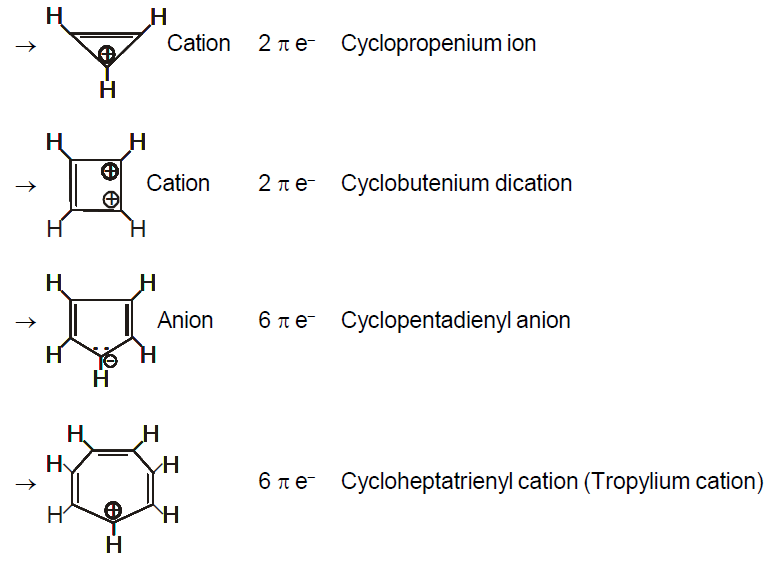
Benzenoid Aromatic Compounds :
Wo sabhi organic compounds jo minimum ek ya usse jyada benzene ring contain karte hai unhe benzenoid aromatic compounds kehte hai.
Spiro Compounds :
Aise compounds jahan ek particular atom ko 2 rings share karti hai unhe spiro compounds kaha jata hai.

Fused Bicyclic Compounds :
Aise compounds jahan 2 adjacent carbon atoms ko 2 rings aapas meh share karti hai unhe fused bicyclic compounds kaha jata hai.

Bridged Bicyclic Compounds :
Aise compounds jahan more than 2 carbon atoms ko 2 rings aapas meh share karti hai unhe bridged bicyclic compounds kaha jata hai.

Isolated Bicyclic Compounds :
Aise compounds jahan two rings directly sigma bond ke through attached hoti hai unhe isolated bicyclic compounds kaha jata hai.

Classification of Organic Compounds

Some of the examples with their classsifications are discussed below :

Aromatic Compound [The Huckel (4n+2)π Rule] :
In order to predict ki particular compound aromatic hai ya nahi, uske liye hum following three rules use karte hai :
1) Aromatic compounds humesha cyclic or planar hote hai.
2) Har ek carbon atom aromatic ring meh sp2 ya sp hybridised hota hai aur ye close conjugation bhi possess karta hai.
3) p−orbitals ki overlap se bane cyclic π molecular orbital meh hamesha (4n+2)π (i.e 2,6,10,14….etc) electrons hote hai yahan par n= integer (0,1,2,3….) hota hai.
Non-Benzenoid Compounds :

Benzenoid Aromatic Compounds :
Wo sabhi organic compounds jo minimum ek ya usse jyada benzene ring contain karte hai unhe benzenoid aromatic compounds kehte hai.
Spiro Compounds :
Aise compounds jahan ek particular atom ko 2 rings share karti hai unhe spiro compounds kaha jata hai.

Fused Bicyclic Compounds :
Aise compounds jahan 2 adjacent carbon atoms ko 2 rings aapas meh share karti hai unhe fused bicyclic compounds kaha jata hai.

Bridged Bicyclic Compounds :
Aise compounds jahan more than 2 carbon atoms ko 2 rings aapas meh share karti hai unhe bridged bicyclic compounds kaha jata hai.

Isolated Bicyclic Compounds :
Aise compounds jahan two rings directly sigma bond ke through attached hoti hai unhe isolated bicyclic compounds kaha jata hai.

Classification of Organic Compounds

Some of the examples with their classsifications are discussed below :

Aromatic Compound [The Huckel (4n+2)π Rule] :
In order to predict ki particular compound aromatic hai ya nahi, uske liye hum following three rules use karte hai :
1) Aromatic compounds humesha cyclic or planar hote hai.
2) Har ek carbon atom aromatic ring meh sp2 ya sp hybridised hota hai aur ye close conjugation bhi possess karta hai.
3) p−orbitals ki overlap se bane cyclic π molecular orbital meh hamesha (4n+2)π (i.e 2,6,10,14….etc) electrons hote hai yahan par n= integer (0,1,2,3….) hota hai.
Non-Benzenoid Compounds :

Benzenoid Aromatic Compounds :
Wo sabhi organic compounds jo minimum ek ya usse jyada benzene ring contain karte hai unhe benzenoid aromatic compounds kehte hai.
Spiro Compounds :
Aise compounds jahan ek particular atom ko 2 rings share karti hai unhe spiro compounds kaha jata hai.

Fused Bicyclic Compounds :
Aise compounds jahan 2 adjacent carbon atoms ko 2 rings aapas meh share karti hai unhe fused bicyclic compounds kaha jata hai.

Bridged Bicyclic Compounds :
Aise compounds jahan more than 2 carbon atoms ko 2 rings aapas meh share karti hai unhe bridged bicyclic compounds kaha jata hai.

Isolated Bicyclic Compounds :
Aise compounds jahan two rings directly sigma bond ke through attached hoti hai unhe isolated bicyclic compounds kaha jata hai.

Classification of Organic Compounds

Some of the examples with their classsifications are discussed below :

Aromatic Compound [The Huckel (4n+2)π Rule] :
In order to predict ki particular compound aromatic hai ya nahi, uske liye hum following three rules use karte hai :
1) Aromatic compounds humesha cyclic or planar hote hai.
2) Har ek carbon atom aromatic ring meh sp2 ya sp hybridised hota hai aur ye close conjugation bhi possess karta hai.
3) p−orbitals ki overlap se bane cyclic π molecular orbital meh hamesha (4n+2)π (i.e 2,6,10,14….etc) electrons hote hai yahan par n= integer (0,1,2,3….) hota hai.
Non-Benzenoid Compounds :

Benzenoid Aromatic Compounds :
Wo sabhi organic compounds jo minimum ek ya usse jyada benzene ring contain karte hai unhe benzenoid aromatic compounds kehte hai.
Spiro Compounds :
Aise compounds jahan ek particular atom ko 2 rings share karti hai unhe spiro compounds kaha jata hai.

Fused Bicyclic Compounds :
Aise compounds jahan 2 adjacent carbon atoms ko 2 rings aapas meh share karti hai unhe fused bicyclic compounds kaha jata hai.

Bridged Bicyclic Compounds :
Aise compounds jahan more than 2 carbon atoms ko 2 rings aapas meh share karti hai unhe bridged bicyclic compounds kaha jata hai.

Isolated Bicyclic Compounds :
Aise compounds jahan two rings directly sigma bond ke through attached hoti hai unhe isolated bicyclic compounds kaha jata hai.

Classification of Organic Compounds

Some of the classifications with their examples are discussed below :

Aromatic Compound [The Huckel (4n+2)π Rule] :
The following three rules are useful in predicting whether a particular compound is aromatic or non- aromatic :
1) Aromatic compounds are cyclic and planar.
2) Each atom in an aromatic ring is sp2 or sp hybridised and has close conjugation.
3) The cyclic molecular orbital (formed by overlap of p-orbitals) must contain (4n+2)π (i.e 2,6,10,14….etc) electrons where n= integer (0,1,2,3….).
Non-Benzenoid Compounds :

Benzenoid Aromatic Compounds :
All organic compounds which contains atleast one benzene ring are known as benzenoid aromatic compounds.
Spiro Compounds :
One atom shared by two rings.

Fused Bicyclic Compounds :
Two adjacent atoms shared by two rings.

Bridged Bicyclic Compounds :
More than two atoms shared by two rings.

Isolated Bicyclic Compounds :
Two rings directly attached by a sigma bond.

Classification of Organic Compounds

Some of the classifications with their examples are discussed below :

Aromatic Compound [The Huckel (4n+2)π Rule] :
The following three rules are useful in predicting whether a particular compound is aromatic or non- aromatic :
1) Aromatic compounds are cyclic and planar.
2) Each atom in an aromatic ring is sp2 or sp hybridised and has close conjugation.
3) The cyclic molecular orbital (formed by overlap of p-orbitals) must contain (4n+2)π (i.e 2,6,10,14….etc) electrons where n= integer (0,1,2,3….).
Non-Benzenoid Compounds :

Benzenoid Aromatic Compounds :
All organic compounds which contains atleast one benzene ring are known as benzenoid aromatic compounds.
Spiro Compounds :
One atom shared by two rings.

Fused Bicyclic Compounds :
Two adjacent atoms shared by two rings.

Bridged Bicyclic Compounds :
More than two atoms shared by two rings.

Isolated Bicyclic Compounds :
Two rings directly attached by a sigma bond.

Classification of Organic Compounds

Some of the classifications with their examples are discussed below :

Aromatic Compound [The Huckel (4n+2)π Rule] :
The following three rules are useful in predicting whether a particular compound is aromatic or non- aromatic :
1) Aromatic compounds are cyclic and planar.
2) Each atom in an aromatic ring is sp2 or sp hybridised and has close conjugation.
3) The cyclic molecular orbital (formed by overlap of p-orbitals) must contain (4n+2)π (i.e 2,6,10,14….etc) electrons where n= integer (0,1,2,3….).
Non-Benzenoid Compounds :

Benzenoid Aromatic Compounds :
All organic compounds which contains atleast one benzene ring are known as benzenoid aromatic compounds.
Spiro Compounds :
One atom shared by two rings.

Fused Bicyclic Compounds :
Two adjacent atoms shared by two rings.

Bridged Bicyclic Compounds :
More than two atoms shared by two rings.

Isolated Bicyclic Compounds :
Two rings directly attached by a sigma bond.

Classification of Organic Compounds

Some of the classifications with their examples are discussed below :

Aromatic Compound [The Huckel (4n+2)π Rule] :
The following three rules are useful in predicting whether a particular compound is aromatic or non- aromatic :
1) Aromatic compounds are cyclic and planar.
2) Each atom in an aromatic ring is sp2 or sp hybridised and has close conjugation.
3) The cyclic molecular orbital (formed by overlap of p-orbitals) must contain (4n+2)π (i.e 2,6,10,14….etc) electrons where n= integer (0,1,2,3….).
Non-Benzenoid Compounds :

Benzenoid Aromatic Compounds :
All organic compounds which contains atleast one benzene ring are known as benzenoid aromatic compounds.
Spiro Compounds :
One atom shared by two rings.

Fused Bicyclic Compounds :
Two adjacent atoms shared by two rings.

Bridged Bicyclic Compounds :
More than two atoms shared by two rings.

Isolated Bicyclic Compounds :
Two rings directly attached by a sigma bond.

Hello Points!
Common Names of Some Organic Compounds
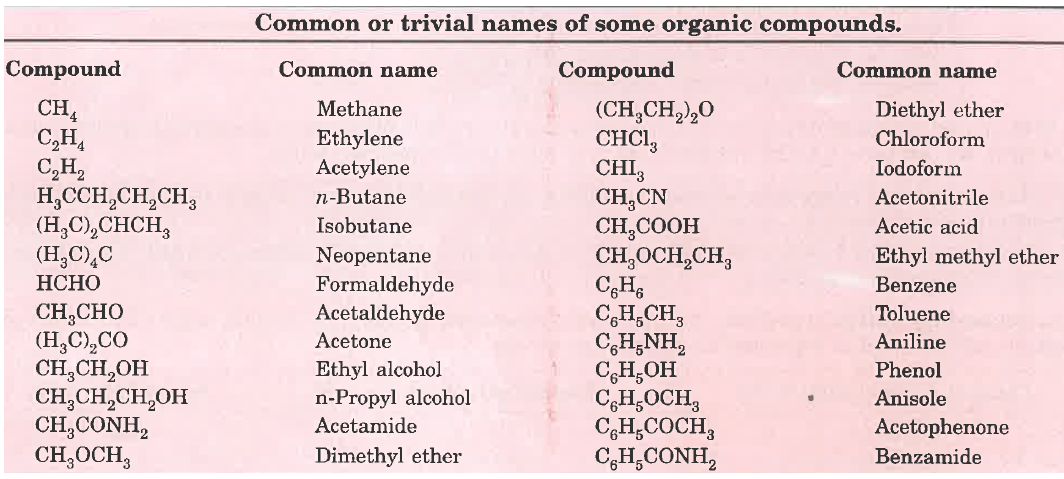
Hello Points!
Common Names of Some Organic Compounds

Hello Points!
Common Names of Some Organic Compounds

Hello Points!
Common Names of Some Organic Compounds

IUPAC Nomenclature of Organic Compounds
General Scheme of Naming
1) Word Root : Ye main/parent chain meh present no. of carbon atoms ko indicate karta hai. Isse “Alk” se represent karte hai.

2) Primary Suffix : Ye chain meh present saturation ya unsaturation ko indicate karta hai.
ane → single − bond (saturated)
ene → double = bond (unsaturated)
diene → two double = bonds
Polyene → plenty of double = bonds present
yne → one triple ≡ bond
diyne → two triple ≡ bonds
3) Secondary Suffix : Ye principal functional group ke liye use kiya jata hai.
4) Primary Prefix : ‘Cyclo’ word ko hum cyclic compounds ke liye use karte hai.
5) Secondary Prefix : Normal substituents aur junior functional groups ko substituent ki tarah treat kiya jata hai aur fir unke name se secondary prefix derive hota hai.
Kuch common substituents :

- Prefixes ko hamesha alphabetical order meh likha jata hai.
- Main carbon chain meh kisi substituent ki position likhne ke liye hum simply hyphen (−) laga kar uska no. likhte hai before its name.
IUPAC Nomenclature of Organic Compounds
General Scheme of Naming
1) Word Root : Ye main/parent chain meh present no. of carbon atoms ko indicate karta hai. Isse “Alk” se represent karte hai.

2) Primary Suffix : Ye chain meh present saturation ya unsaturation ko indicate karta hai.
ane → single − bond (saturated)
ene → double = bond (unsaturated)
diene → two double = bonds
Polyene → plenty of double = bonds present
yne → one triple ≡ bond
diyne → two triple ≡ bonds
3) Secondary Suffix : Ye principal functional group ke liye use kiya jata hai.
4) Primary Prefix : ‘Cyclo’ word ko hum cyclic compounds ke liye use karte hai.
5) Secondary Prefix : Normal substituents aur junior functional groups ko substituent ki tarah treat kiya jata hai aur fir unke name se secondary prefix derive hota hai.
Kuch common substituents :

- Prefixes ko hamesha alphabetical order meh likha jata hai.
- Main carbon chain meh kisi substituent ki position likhne ke liye hum simply hyphen (−) laga kar uska no. likhte hai before its name.
IUPAC Nomenclature of Organic Compounds
General Scheme of Naming
1) Word Root : Ye main/parent chain meh present no. of carbon atoms ko indicate karta hai. Isse “Alk” se represent karte hai.

2) Primary Suffix : Ye chain meh present saturation ya unsaturation ko indicate karta hai.
ane → single − bond (saturated)
ene → double = bond (unsaturated)
diene → two double = bonds
Polyene → plenty of double = bonds present
yne → one triple ≡ bond
diyne → two triple ≡ bonds
3) Secondary Suffix : Ye principal functional group ke liye use kiya jata hai.
4) Primary Prefix : ‘Cyclo’ word ko hum cyclic compounds ke liye use karte hai.
5) Secondary Prefix : Normal substituents aur junior functional groups ko substituent ki tarah treat kiya jata hai aur fir unke name se secondary prefix derive hota hai.
Kuch common substituents :

- Prefixes ko hamesha alphabetical order meh likha jata hai.
- Main carbon chain meh kisi substituent ki position likhne ke liye hum simply hyphen (−) laga kar uska no. likhte hai before its name.
IUPAC Nomenclature of Organic Compounds
General Scheme of Naming
1) Word Root : Ye main/parent chain meh present no. of carbon atoms ko indicate karta hai. Isse “Alk” se represent karte hai.

2) Primary Suffix : Ye chain meh present saturation ya unsaturation ko indicate karta hai.
ane → single − bond (saturated)
ene → double = bond (unsaturated)
diene → two double = bonds
Polyene → plenty of double = bonds present
yne → one triple ≡ bond
diyne → two triple ≡ bonds
3) Secondary Suffix : Ye principal functional group ke liye use kiya jata hai.
4) Primary Prefix : ‘Cyclo’ word ko hum cyclic compounds ke liye use karte hai.
5) Secondary Prefix : Normal substituents aur junior functional groups ko substituent ki tarah treat kiya jata hai aur fir unke name se secondary prefix derive hota hai.
Kuch common substituents :

- Prefixes ko hamesha alphabetical order meh likha jata hai.
- Main carbon chain meh kisi substituent ki position likhne ke liye hum simply hyphen (−) laga kar uska no. likhte hai before its name.
IUPAC Nomenclature of Organic Compounds
General Scheme of Naming
1) Word Root : It indicates the no. of carbon atoms present in the main chain (parent chain). It is represented as Alk.

2) Primary Suffix : It indicates the saturation or unsaturation existing in the main chain.
ane → single − bond (saturated)
ene → double = bond (unsaturated)
diene → two double = bonds
Polyene → plenty of double = bonds present
yne → one triple ≡ bond
diyne → two triple ≡ bonds
3) Secondary Suffix : It is used for the principal functional group.
4) Primary Prefix : ‘Cyclo’ word is used for cyclic compounds
5) Secondary Prefix : Normal substituents and junior functional groups are treated as substituents and then their name is treated as secondary prefix.
The following substituent groups are always cited in the prefix :

- The prefixes are always written in alphabetical order.
- The position of the substituent group in the main carbon chain is mentioned by writing the number just before the name of substituent by writing a hyphen (−).
IUPAC Nomenclature of Organic Compounds
General Scheme of Naming
1) Word Root : It indicates the no. of carbon atoms present in the main chain (parent chain). It is represented as Alk.

2) Primary Suffix : It indicates the saturation or unsaturation existing in the main chain.
ane → single − bond (saturated)
ene → double = bond (unsaturated)
diene → two double = bonds
Polyene → plenty of double = bonds present
yne → one triple ≡ bond
diyne → two triple ≡ bonds
3) Secondary Suffix : It is used for the principal functional group.
4) Primary Prefix : ‘Cyclo’ word is used for cyclic compounds
5) Secondary Prefix : Normal substituents and junior functional groups are treated as substituents and then their name is treated as secondary prefix.
The following substituent groups are always cited in the prefix :

- The prefixes are always written in alphabetical order.
- The position of the substituent group in the main carbon chain is mentioned by writing the number just before the name of substituent by writing a hyphen (−).
IUPAC Nomenclature of Organic Compounds
General Scheme of Naming
1) Word Root : It indicates the no. of carbon atoms present in the main chain (parent chain). It is represented as Alk.

2) Primary Suffix : It indicates the saturation or unsaturation existing in the main chain.
ane → single − bond (saturated)
ene → double = bond (unsaturated)
diene → two double = bonds
Polyene → plenty of double = bonds present
yne → one triple ≡ bond
diyne → two triple ≡ bonds
3) Secondary Suffix : It is used for the principal functional group.
4) Primary Prefix : ‘Cyclo’ word is used for cyclic compounds
5) Secondary Prefix : Normal substituents and junior functional groups are treated as substituents and then their name is treated as secondary prefix.
The following substituent groups are always cited in the prefix :

- The prefixes are always written in alphabetical order.
- The position of the substituent group in the main carbon chain is mentioned by writing the number just before the name of substituent by writing a hyphen (−).
IUPAC Nomenclature of Organic Compounds
General Scheme of Naming
1) Word Root : It indicates the no. of carbon atoms present in the main chain (parent chain). It is represented as Alk.

2) Primary Suffix : It indicates the saturation or unsaturation existing in the main chain.
ane → single − bond (saturated)
ene → double = bond (unsaturated)
diene → two double = bonds
Polyene → plenty of double = bonds present
yne → one triple ≡ bond
diyne → two triple ≡ bonds
3) Secondary Suffix : It is used for the principal functional group.
4) Primary Prefix : ‘Cyclo’ word is used for cyclic compounds
5) Secondary Prefix : Normal substituents and junior functional groups are treated as substituents and then their name is treated as secondary prefix.
The following substituent groups are always cited in the prefix :

- The prefixes are always written in alphabetical order.
- The position of the substituent group in the main carbon chain is mentioned by writing the number just before the name of substituent by writing a hyphen (−).
Naming of Saturated Hydrocarbons
Rules : (Branched and substituted Alkanes)
Selection of Parent Chain :
(a) Maximum no. of carbon atoms wali chain parent chain hoti hai.
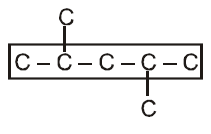
(b) Agar 2 chains meh parent chain decide karte waqt no. of carbons same ho toh hum jayda substituted chain ko parent chain consider karte hai.
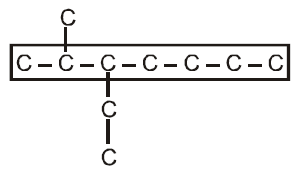
(c) Agar no. of side chains bhi same ho, toh jis chain meh substituents lower number par honge, wo parent chain hoti hai.
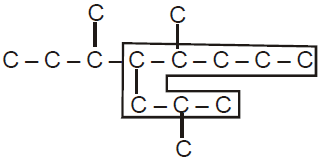
Numbering :
(a) Numbering hum hamesha lowest set of locants rule se karte hai. Iss rule ke according parent chain ki numbering uss direction se hoti hai jahan se substituent ko lowest number milta hai.

(b) Agar kisi substituent ki position, chain ke dono sides se same ho tab hum numbering alphabetical order meh karte hai.

Agar certain case meh alphabets bhi same ho tab numbering of parent chain hum uss side se karte hai jahan se substituent ko lowest number mile.
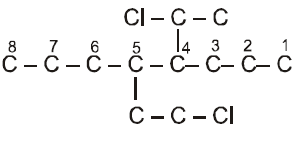
Some of the named examples are given below :
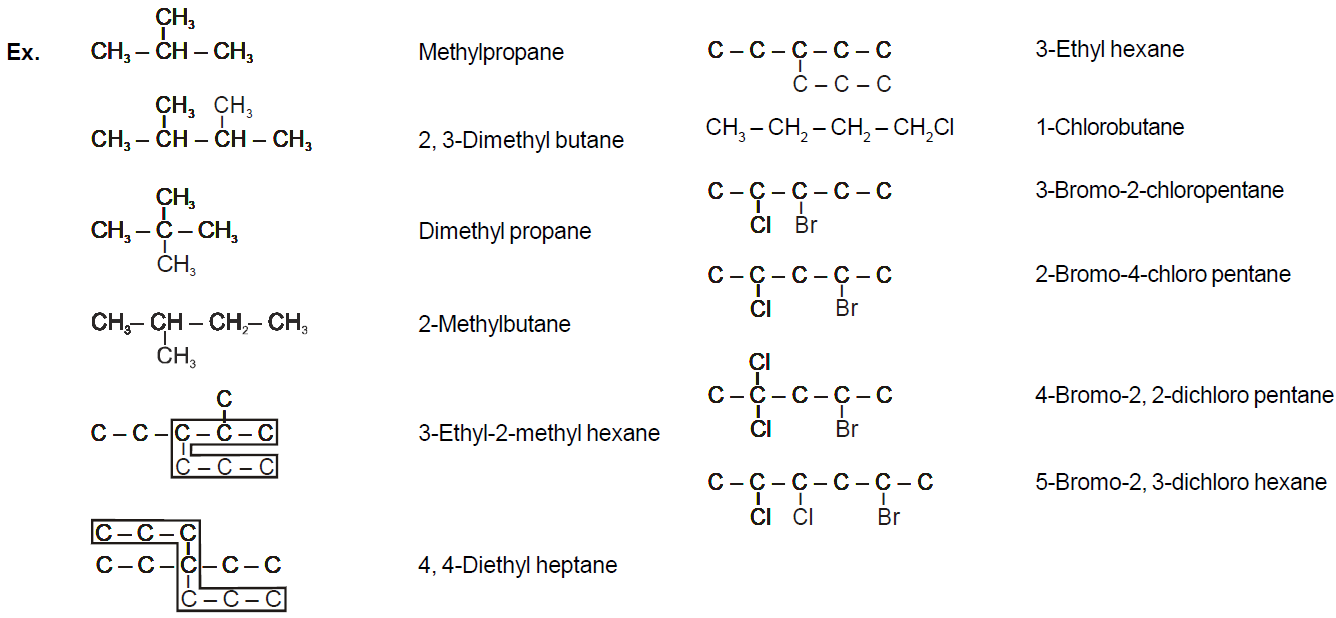
Rules for Writing Radicals :
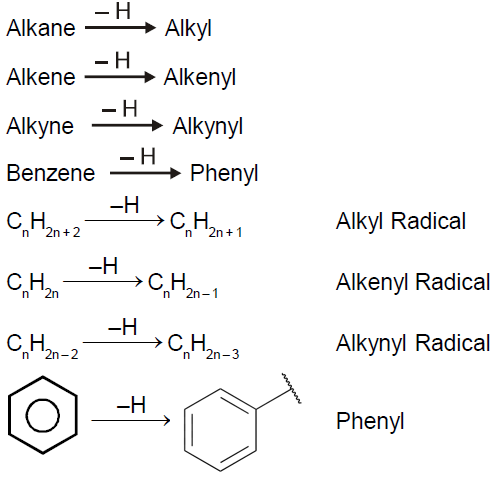
Some of the named examples are given below :
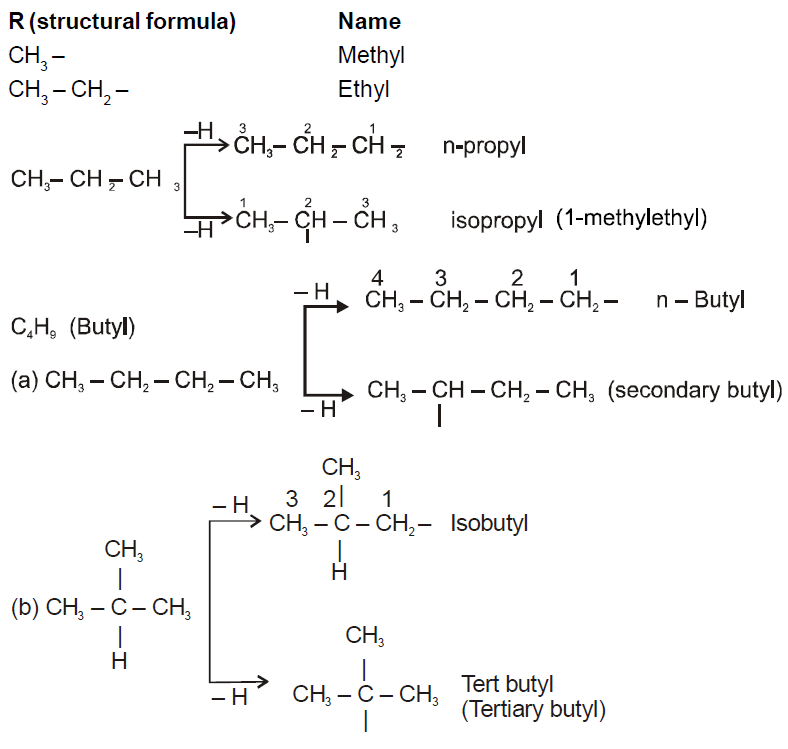
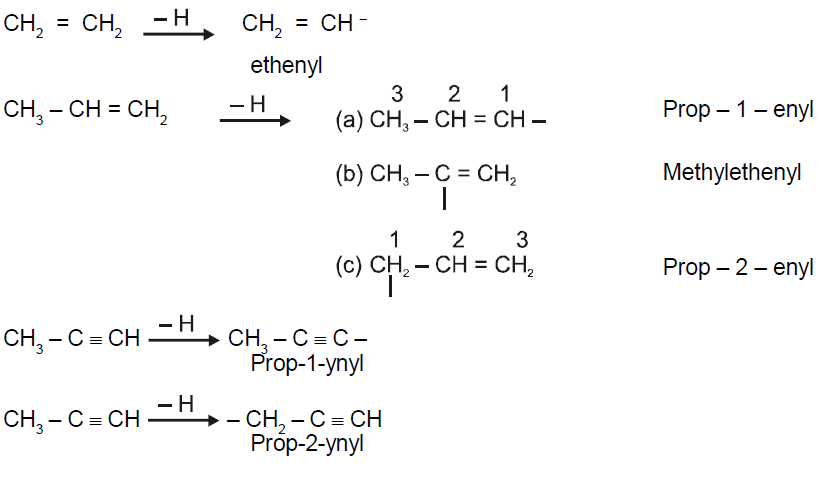
Benzene Radical :
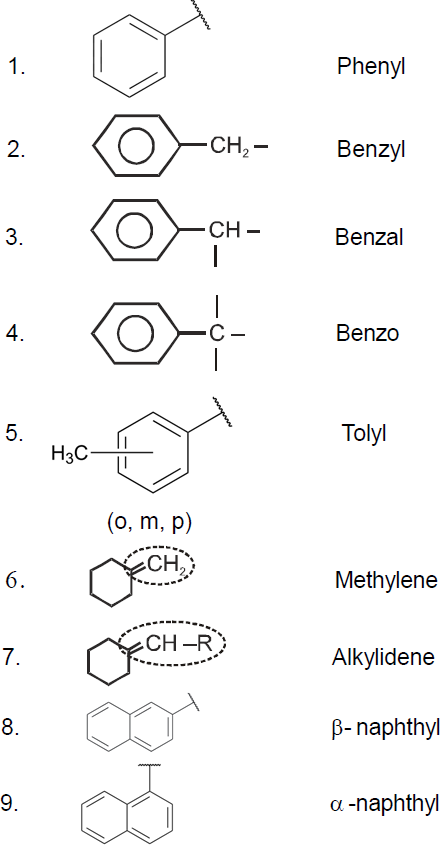
Systematic Names of Radicals :
Complex Radical :
Some of the named examples are given below :
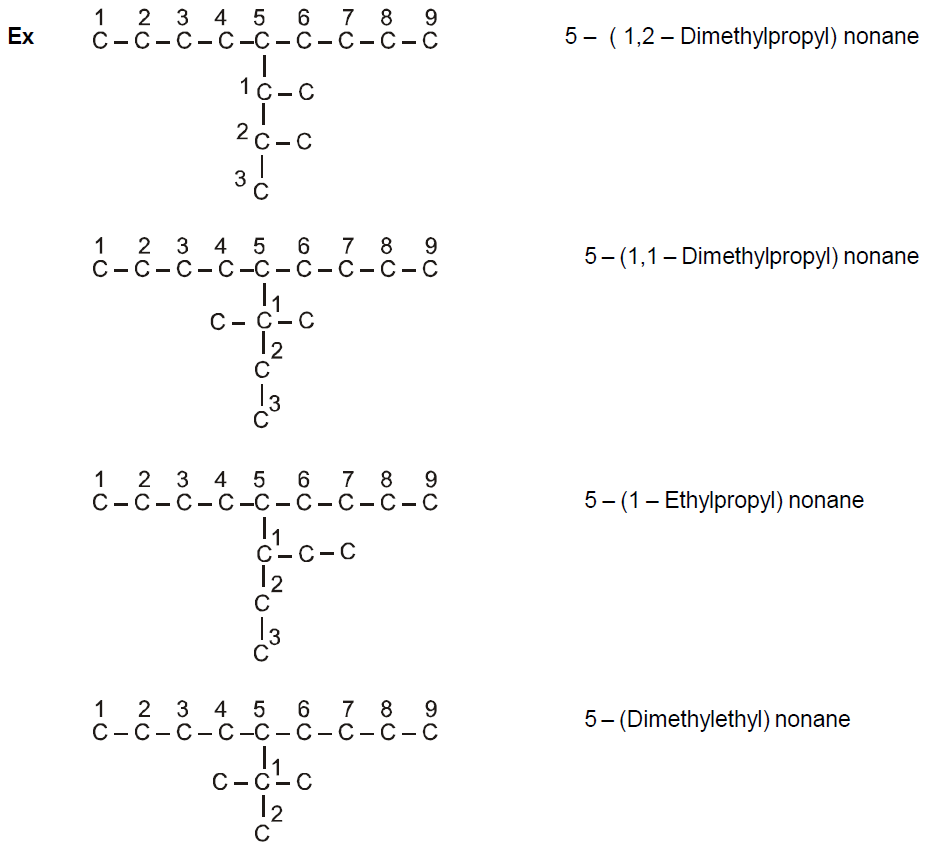
Numeral Prefixes :
1) Following prefixes ko hum alphabetization ke liye use karte hai :
(a) Iso

(b) Neo
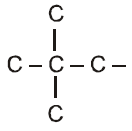
(c) Kisi complex radical meh di, tri, tetra ko alphabetize karte hai.
2) Following radicals ko hum alphabetize karne ke liye consider nahi karte :
(a) Di, Tri, Tetra for simple radicals.
(b) Sec, tert ko bhi alphabetization ke liye consider nahi karte.
(c) Bis aur Tris
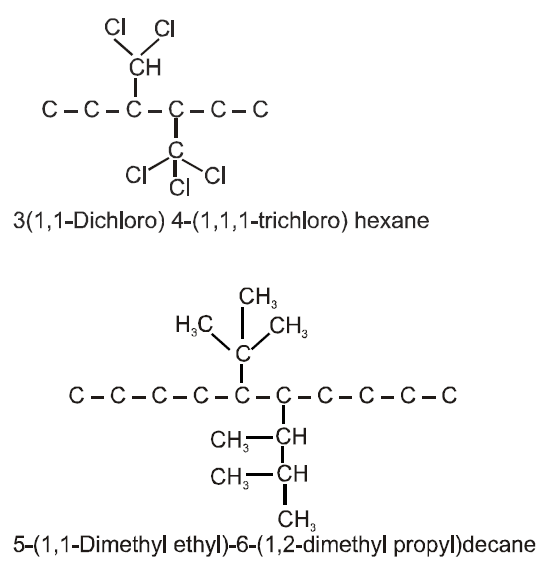
Retained Names for Alkanes :
1) Normal (n) : Agar kisi radical or hydrocarbon jiske paas straight chain hai aur agar iske paas free valency bhi hai tab ye either ends par present ho sakta hai.

2) Iso : Linear chain meh kisi ek end par jab 2 methyl groups present hote hai tab hum iso prefix use karte hai.
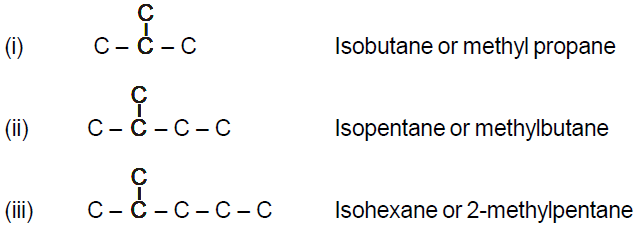
Conditions :
- Chain meh dusra koi alkyl group present nahi hota hai.
- Chain meh sirf 4−6 carbon atoms present hote hai.
3) Neo :
Conditions :
- Chain meh 5−6 carbon atoms present hote hai.
- Usually iss case meh ek carbon atom 4 other carbon atoms se surrounded hota hai.
- Yahan other substituent present nahi hote hai.
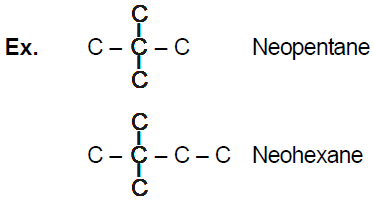
4) Secondary : Ye sirf radicals ke liye applicable hota hai. Agar kisi carbon ke around two more carbon atoms present ho toh wo secondary hota hai.

5) Tertiary : Inn radicals meh ek carbon atom 3 other carbon atoms se surrounded hota hai.
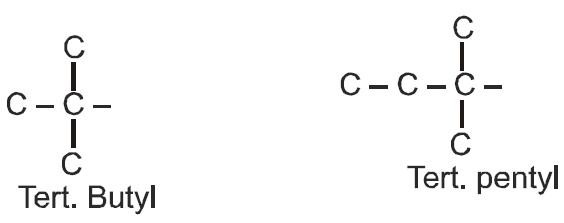
Naming of Saturated Hydrocarbons
Rules : (Branched and substituted Alkanes)
Selection of Parent Chain :
(a) Maximum no. of carbon atoms wali chain parent chain hoti hai.

(b) Agar 2 chains meh parent chain decide karte waqt no. of carbons same ho toh hum jayda substituted chain ko parent chain consider karte hai.

(c) Agar no. of side chains bhi same ho, toh jis chain meh substituents lower number par honge, wo parent chain hoti hai.

Numbering :
(a) Numbering hum hamesha lowest set of locants rule se karte hai. Iss rule ke according parent chain ki numbering uss direction se hoti hai jahan se substituent ko lowest number milta hai.

(b) Agar kisi substituent ki position, chain ke dono sides se same ho tab hum numbering alphabetical order meh karte hai.

Agar certain case meh alphabets bhi same ho tab numbering of parent chain hum uss side se karte hai jahan se substituent ko lowest number mile.

Some of the named examples are given below :

Rules for Writing Radicals :

Some of the named examples are given below :


Benzene Radical :

Systematic Names of Radicals :
Complex Radical :
Some of the named examples are given below :

Numeral Prefixes :
1) Following prefixes ko hum alphabetization ke liye use karte hai :
(a) Iso

(b) Neo

(c) Kisi complex radical meh di, tri, tetra ko alphabetize karte hai.
2) Following radicals ko hum alphabetize karne ke liye consider nahi karte :
(a) Di, Tri, Tetra for simple radicals.
(b) Sec, tert ko bhi alphabetization ke liye consider nahi karte.
(c) Bis aur Tris

Retained Names for Alkanes :
1) Normal (n) : Agar kisi radical or hydrocarbon jiske paas straight chain hai aur agar iske paas free valency bhi hai tab ye either ends par present ho sakta hai.

2) Iso : Linear chain meh kisi ek end par jab 2 methyl groups present hote hai tab hum iso prefix use karte hai.

Conditions :
- Chain meh dusra koi alkyl group present nahi hota hai.
- Chain meh sirf 4−6 carbon atoms present hote hai.
3) Neo :
Conditions :
- Chain meh 5−6 carbon atoms present hote hai.
- Usually iss case meh ek carbon atom 4 other carbon atoms se surrounded hota hai.
- Yahan other substituent present nahi hote hai.

4) Secondary : Ye sirf radicals ke liye applicable hota hai. Agar kisi carbon ke around two more carbon atoms present ho toh wo secondary hota hai.

5) Tertiary : Inn radicals meh ek carbon atom 3 other carbon atoms se surrounded hota hai.

Naming of Saturated Hydrocarbons
Rules : (Branched and substituted Alkanes)
Selection of Parent Chain :
(a) Maximum no. of carbon atoms wali chain parent chain hoti hai.

(b) Agar 2 chains meh parent chain decide karte waqt no. of carbons same ho toh hum jayda substituted chain ko parent chain consider karte hai.

(c) Agar no. of side chains bhi same ho, toh jis chain meh substituents lower number par honge, wo parent chain hoti hai.

Numbering :
(a) Numbering hum hamesha lowest set of locants rule se karte hai. Iss rule ke according parent chain ki numbering uss direction se hoti hai jahan se substituent ko lowest number milta hai.

(b) Agar kisi substituent ki position, chain ke dono sides se same ho tab hum numbering alphabetical order meh karte hai.

Agar certain case meh alphabets bhi same ho tab numbering of parent chain hum uss side se karte hai jahan se substituent ko lowest number mile.

Some of the named examples are given below :

Rules for Writing Radicals :

Some of the named examples are given below :


Benzene Radical :

Systematic Names of Radicals :
Complex Radical :
Some of the named examples are given below :

Numeral Prefixes :
1) Following prefixes ko hum alphabetization ke liye use karte hai :
(a) Iso

(b) Neo

(c) Kisi complex radical meh di, tri, tetra ko alphabetize karte hai.
2) Following radicals ko hum alphabetize karne ke liye consider nahi karte :
(a) Di, Tri, Tetra for simple radicals.
(b) Sec, tert ko bhi alphabetization ke liye consider nahi karte.
(c) Bis aur Tris

Retained Names for Alkanes :
1) Normal (n) : Agar kisi radical or hydrocarbon jiske paas straight chain hai aur agar iske paas free valency bhi hai tab ye either ends par present ho sakta hai.

2) Iso : Linear chain meh kisi ek end par jab 2 methyl groups present hote hai tab hum iso prefix use karte hai.

Conditions :
- Chain meh dusra koi alkyl group present nahi hota hai.
- Chain meh sirf 4−6 carbon atoms present hote hai.
3) Neo :
Conditions :
- Chain meh 5−6 carbon atoms present hote hai.
- Usually iss case meh ek carbon atom 4 other carbon atoms se surrounded hota hai.
- Yahan other substituent present nahi hote hai.

4) Secondary : Ye sirf radicals ke liye applicable hota hai. Agar kisi carbon ke around two more carbon atoms present ho toh wo secondary hota hai.

5) Tertiary : Inn radicals meh ek carbon atom 3 other carbon atoms se surrounded hota hai.

Naming of Saturated Hydrocarbons
Rules : (Branched and substituted Alkanes)
Selection of Parent Chain :
(a) Maximum no. of carbon atoms wali chain parent chain hoti hai.

(b) Agar 2 chains meh parent chain decide karte waqt no. of carbons same ho toh hum jayda substituted chain ko parent chain consider karte hai.

(c) Agar no. of side chains bhi same ho, toh jis chain meh substituents lower number par honge, wo parent chain hoti hai.

Numbering :
(a) Numbering hum hamesha lowest set of locants rule se karte hai. Iss rule ke according parent chain ki numbering uss direction se hoti hai jahan se substituent ko lowest number milta hai.

(b) Agar kisi substituent ki position, chain ke dono sides se same ho tab hum numbering alphabetical order meh karte hai.

Agar certain case meh alphabets bhi same ho tab numbering of parent chain hum uss side se karte hai jahan se substituent ko lowest number mile.

Some of the named examples are given below :

Rules for Writing Radicals :

Some of the named examples are given below :


Benzene Radical :

Systematic Names of Radicals :
Complex Radical :
Some of the named examples are given below :

Numeral Prefixes :
1) Following prefixes ko hum alphabetization ke liye use karte hai :
(a) Iso

(b) Neo

(c) Kisi complex radical meh di, tri, tetra ko alphabetize karte hai.
2) Following radicals ko hum alphabetize karne ke liye consider nahi karte :
(a) Di, Tri, Tetra for simple radicals.
(b) Sec, tert ko bhi alphabetization ke liye consider nahi karte.
(c) Bis aur Tris

Retained Names for Alkanes :
1) Normal (n) : Agar kisi radical or hydrocarbon jiske paas straight chain hai aur agar iske paas free valency bhi hai tab ye either ends par present ho sakta hai.

2) Iso : Linear chain meh kisi ek end par jab 2 methyl groups present hote hai tab hum iso prefix use karte hai.

Conditions :
- Chain meh dusra koi alkyl group present nahi hota hai.
- Chain meh sirf 4−6 carbon atoms present hote hai.
3) Neo :
Conditions :
- Chain meh 5−6 carbon atoms present hote hai.
- Usually iss case meh ek carbon atom 4 other carbon atoms se surrounded hota hai.
- Yahan other substituent present nahi hote hai.

4) Secondary : Ye sirf radicals ke liye applicable hota hai. Agar kisi carbon ke around two more carbon atoms present ho toh wo secondary hota hai.

5) Tertiary : Inn radicals meh ek carbon atom 3 other carbon atoms se surrounded hota hai.

Naming of Saturated Hydrocarbons
Rules : (Branched and substituted Alkanes)
Selection of Parent Chain :
(a) Chain with maximum number of C atoms (longest chain).

(b) If the number of carbon atoms are the same in more than one longest chain then the more substituted longest chain will be the parent chain.

(c) If the number of side chains are also the same then that will be the parent chain having its substituent at lower number.

Numbering :
(a) Numbering is done from that side of the parent chain having it substituent at lower number (lowest set of locant).

(b) If position of substituent is the same from both ends of the parent chain, then numbering is done from alphabetical order.

If alphabets are also same then numbering is done from that side of the parent chain having its substituent of substituent at lower number.

Some of the named examples are given below :

Rules for Writing Radicals

Some of the named examples are given below :


Benzene Radical :

Systematic Names of Radicals :
Complex Radical :
Some of the named examples are given below :

Numeral Prefixes :
1) Following prefixes are considered for alphabetization :
(a) Iso

2) Neo

(c) Di, Tri, Tetra of complex radical are considered for alphabetization.
2) Following radicals are not considered for alphabetization:
(a) Di, Tri, Tetra for simple radicals.
(b) Sec, tert are not considered for alphabetization.
(c) Bis and Tris

Retained Names for Alkanes :
1) Normal (n) : Radical or hydrocarbon which has a straight chain and if it has free valency it must be present at either of ends.

2) Iso : Two methyl groups at the end of linear chain (unbranched chain).

Conditions :
- There should not be any other alkyl group present in the chain.
- There should be 4−6 carbon atoms only.
3) Neo :
Conditions :
- There should be 5−6 carbon atoms.
- One carbon atom is surrounded by 4 carbon atoms.
- No other substituent present.
- 2,2-dimethyl.

4) Secondary : It is applicable only for radicals. If a radical carbon atom is surrounded by two carbon atoms, then it is called secondary.

5) Tertiary : In this case, one carbon atom is surrounded by 3 other carbon atoms.

Naming of Saturated Hydrocarbons
Rules : (Branched and substituted Alkanes)
Selection of Parent Chain :
(a) Chain with maximum number of C atoms (longest chain).

(b) If the number of carbon atoms are the same in more than one longest chain then the more substituted longest chain will be the parent chain.

(c) If the number of side chains are also the same then that will be the parent chain having its substituent at lower number.

Numbering :
(a) Numbering is done from that side of the parent chain having it substituent at lower number (lowest set of locant).

(b) If position of substituent is the same from both ends of the parent chain, then numbering is done from alphabetical order.

If alphabets are also same then numbering is done from that side of the parent chain having its substituent of substituent at lower number.

Some of the named examples are given below :

Rules for Writing Radicals

Some of the named examples are given below :


Benzene Radical :

Systematic Names of Radicals :
Complex Radical :
Some of the named examples are given below :

Numeral Prefixes :
1) Following prefixes are considered for alphabetization :
(a) Iso

2) Neo

(c) Di, Tri, Tetra of complex radical are considered for alphabetization.
2) Following radicals are not considered for alphabetization:
(a) Di, Tri, Tetra for simple radicals.
(b) Sec, tert are not considered for alphabetization.
(c) Bis and Tris

Retained Names for Alkanes :
1) Normal (n) : Radical or hydrocarbon which has a straight chain and if it has free valency it must be present at either of ends.

2) Iso : Two methyl groups at the end of linear chain (unbranched chain).

Conditions :
- There should not be any other alkyl group present in the chain.
- There should be 4−6 carbon atoms only.
3) Neo :
Conditions :
- There should be 5−6 carbon atoms.
- One carbon atom is surrounded by 4 carbon atoms.
- No other substituent present.
- 2,2-dimethyl.

4) Secondary : It is applicable only for radicals. If a radical carbon atom is surrounded by two carbon atoms, then it is called secondary.

5) Tertiary : In this case, one carbon atom is surrounded by 3 other carbon atoms.

Naming of Saturated Hydrocarbons
Rules : (Branched and substituted Alkanes)
Selection of Parent Chain :
(a) Chain with maximum number of C atoms (longest chain).

(b) If the number of carbon atoms are the same in more than one longest chain then the more substituted longest chain will be the parent chain.

(c) If the number of side chains are also the same then that will be the parent chain having its substituent at lower number.

Numbering :
(a) Numbering is done from that side of the parent chain having it substituent at lower number (lowest set of locant).

(b) If position of substituent is the same from both ends of the parent chain, then numbering is done from alphabetical order.

If alphabets are also same then numbering is done from that side of the parent chain having its substituent of substituent at lower number.

Some of the named examples are given below :

Rules for Writing Radicals

Some of the named examples are given below :


Benzene Radical :

Systematic Names of Radicals :
Complex Radical :
Some of the named examples are given below :

Numeral Prefixes :
1) Following prefixes are considered for alphabetization :
(a) Iso

2) Neo

(c) Di, Tri, Tetra of complex radical are considered for alphabetization.
2) Following radicals are not considered for alphabetization:
(a) Di, Tri, Tetra for simple radicals.
(b) Sec, tert are not considered for alphabetization.
(c) Bis and Tris

Retained Names for Alkanes :
1) Normal (n) : Radical or hydrocarbon which has a straight chain and if it has free valency it must be present at either of ends.

2) Iso : Two methyl groups at the end of linear chain (unbranched chain).

Conditions :
- There should not be any other alkyl group present in the chain.
- There should be 4−6 carbon atoms only.
3) Neo :
Conditions :
- There should be 5−6 carbon atoms.
- One carbon atom is surrounded by 4 carbon atoms.
- No other substituent present.
- 2,2-dimethyl.

4) Secondary : It is applicable only for radicals. If a radical carbon atom is surrounded by two carbon atoms, then it is called secondary.

5) Tertiary : In this case, one carbon atom is surrounded by 3 other carbon atoms.

Naming of Saturated Hydrocarbons
Rules : (Branched and substituted Alkanes)
Selection of Parent Chain :
(a) Chain with maximum number of C atoms (longest chain).

(b) If the number of carbon atoms are the same in more than one longest chain then the more substituted longest chain will be the parent chain.

(c) If the number of side chains are also the same then that will be the parent chain having its substituent at lower number.

Numbering :
(a) Numbering is done from that side of the parent chain having it substituent at lower number (lowest set of locant).

(b) If position of substituent is the same from both ends of the parent chain, then numbering is done from alphabetical order.

If alphabets are also same then numbering is done from that side of the parent chain having its substituent of substituent at lower number.

Some of the named examples are given below :

Rules for Writing Radicals

Some of the named examples are given below :


Benzene Radical :

Systematic Names of Radicals :
Complex Radical :
Some of the named examples are given below :

Numeral Prefixes :
1) Following prefixes are considered for alphabetization :
(a) Iso

2) Neo

(c) Di, Tri, Tetra of complex radical are considered for alphabetization.
2) Following radicals are not considered for alphabetization:
(a) Di, Tri, Tetra for simple radicals.
(b) Sec, tert are not considered for alphabetization.
(c) Bis and Tris

Retained Names for Alkanes :
1) Normal (n) : Radical or hydrocarbon which has a straight chain and if it has free valency it must be present at either of ends.

2) Iso : Two methyl groups at the end of linear chain (unbranched chain).

Conditions :
- There should not be any other alkyl group present in the chain.
- There should be 4−6 carbon atoms only.
3) Neo :
Conditions :
- There should be 5−6 carbon atoms.
- One carbon atom is surrounded by 4 carbon atoms.
- No other substituent present.
- 2,2-dimethyl.

4) Secondary : It is applicable only for radicals. If a radical carbon atom is surrounded by two carbon atoms, then it is called secondary.

5) Tertiary : In this case, one carbon atom is surrounded by 3 other carbon atoms.

Naming of Unsaturated Compounds (Alkenes and Alkynes)
(A) General Formula : CnH2nandCnH2n−2 respectively.
(B) Rules for Selection of Main Chain
- Multiple bonds ke sath longest possible chain ko hum parent chain select karte hai.
- Longest chain meh maximum no. of multiple bonds hote hai.
- Agar first aur second factor common ho toh jis chain meh multiple bonds ke locants lowest hote hai toh wo parent chain hoti hai.
- First point of difference tak lowest set of locants rule use hota hai. Multiple bonds ko substituent se jayda priority di jati hai.
- Alphabetization.
(C) Rules for Numbering :
- Double bond ho ya triple bond, lowest set of locants rule first point of difference tak follow hota hai.
- Numbering, naming aur longest chain selection ke liye hum double bond ko triple bond ke over preference dete hai if all the other factors are common.
Some of the named examples are given below :

Naming of Unsaturated Compounds (Alkenes and Alkynes)
(A) General Formula : CnH2nandCnH2n−2 respectively.
(B) Rules for Selection of Main Chain
- Multiple bonds ke sath longest possible chain ko hum parent chain select karte hai.
- Longest chain meh maximum no. of multiple bonds hote hai.
- Agar first aur second factor common ho toh jis chain meh multiple bonds ke locants lowest hote hai toh wo parent chain hoti hai.
- First point of difference tak lowest set of locants rule use hota hai. Multiple bonds ko substituent se jayda priority di jati hai.
- Alphabetization.
(C) Rules for Numbering :
- Double bond ho ya triple bond, lowest set of locants rule first point of difference tak follow hota hai.
- Numbering, naming aur longest chain selection ke liye hum double bond ko triple bond ke over preference dete hai if all the other factors are common.
Some of the named examples are given below :

Naming of Unsaturated Compounds (Alkenes and Alkynes)
(A) General Formula : CnH2nandCnH2n−2 respectively.
(B) Rules for Selection of Main Chain
- Multiple bonds ke sath longest possible chain ko hum parent chain select karte hai.
- Longest chain meh maximum no. of multiple bonds hote hai.
- Agar first aur second factor common ho toh jis chain meh multiple bonds ke locants lowest hote hai toh wo parent chain hoti hai.
- First point of difference tak lowest set of locants rule use hota hai. Multiple bonds ko substituent se jayda priority di jati hai.
- Alphabetization.
(C) Rules for Numbering :
- Double bond ho ya triple bond, lowest set of locants rule first point of difference tak follow hota hai.
- Numbering, naming aur longest chain selection ke liye hum double bond ko triple bond ke over preference dete hai if all the other factors are common.
Some of the named examples are given below :

Naming of Unsaturated Compounds (Alkenes and Alkynes)
(A) General Formula : CnH2nandCnH2n−2 respectively.
(B) Rules for Selection of Main Chain
- Multiple bonds ke sath longest possible chain ko hum parent chain select karte hai.
- Longest chain meh maximum no. of multiple bonds hote hai.
- Agar first aur second factor common ho toh jis chain meh multiple bonds ke locants lowest hote hai toh wo parent chain hoti hai.
- First point of difference tak lowest set of locants rule use hota hai. Multiple bonds ko substituent se jayda priority di jati hai.
- Alphabetization.
(C) Rules for Numbering :
- Double bond ho ya triple bond, lowest set of locants rule first point of difference tak follow hota hai.
- Numbering, naming aur longest chain selection ke liye hum double bond ko triple bond ke over preference dete hai if all the other factors are common.
Some of the named examples are given below :

Naming of Unsaturated Compounds (Alkenes and Alkynes)
(A) General Formula : CnH2nandCnH2n−2 respectively.
(B) Rules for Selection of Main Chain
- Longest carbon chain with a multiple bond.
- Longest carbon chain with maximum number of multiple bonds.
- If the first and second factor are common then the chain with lowest locant (multiple bond) is selected as the main chain.
- Lowest locant Rule is followed till first point of difference (Multiple bond prior to substituent).
- Alphabetization.
(C) Rules for Numbering :
- Lowest locant rule till first point of difference (irrespective of double bond or triple bond).
- Then double bond is preferred over triple bond in numbering, naming and longest chain selection, if all the other factors are common.
Some of the named examples are given below :

Naming of Unsaturated Compounds (Alkenes and Alkynes)
(A) General Formula : CnH2nandCnH2n−2 respectively.
(B) Rules for Selection of Main Chain
- Longest carbon chain with a multiple bond.
- Longest carbon chain with maximum number of multiple bonds.
- If the first and second factor are common then the chain with lowest locant (multiple bond) is selected as the main chain.
- Lowest locant Rule is followed till first point of difference (Multiple bond prior to substituent).
- Alphabetization.
(C) Rules for Numbering :
- Lowest locant rule till first point of difference (irrespective of double bond or triple bond).
- Then double bond is preferred over triple bond in numbering, naming and longest chain selection, if all the other factors are common.
Some of the named examples are given below :

Naming of Unsaturated Compounds (Alkenes and Alkynes)
(A) General Formula : CnH2nandCnH2n−2 respectively.
(B) Rules for Selection of Main Chain
- Longest carbon chain with a multiple bond.
- Longest carbon chain with maximum number of multiple bonds.
- If the first and second factor are common then the chain with lowest locant (multiple bond) is selected as the main chain.
- Lowest locant Rule is followed till first point of difference (Multiple bond prior to substituent).
- Alphabetization.
(C) Rules for Numbering :
- Lowest locant rule till first point of difference (irrespective of double bond or triple bond).
- Then double bond is preferred over triple bond in numbering, naming and longest chain selection, if all the other factors are common.
Some of the named examples are given below :

Naming of Unsaturated Compounds (Alkenes and Alkynes)
(A) General Formula : CnH2nandCnH2n−2 respectively.
(B) Rules for Selection of Main Chain
- Longest carbon chain with a multiple bond.
- Longest carbon chain with maximum number of multiple bonds.
- If the first and second factor are common then the chain with lowest locant (multiple bond) is selected as the main chain.
- Lowest locant Rule is followed till first point of difference (Multiple bond prior to substituent).
- Alphabetization.
(C) Rules for Numbering :
- Lowest locant rule till first point of difference (irrespective of double bond or triple bond).
- Then double bond is preferred over triple bond in numbering, naming and longest chain selection, if all the other factors are common.
Some of the named examples are given below :

EXAMPLE 1
Give the IUPAC name of the compound CH3CH=C∣CH3−C∣BrH−CH3.
The IUPAC name of the given compound is 4−Bromo−3−methylpent−2−ene.
EXAMPLE 1
Give the IUPAC name of the compound CH3CH=C∣CH3−C∣BrH−CH3.
The IUPAC name of the given compound is 4−Bromo−3−methylpent−2−ene.
EXAMPLE 1
Give the IUPAC name of the compound CH3CH=C∣CH3−C∣BrH−CH3.
The IUPAC name of the given compound is 4−Bromo−3−methylpent−2−ene.
EXAMPLE 1
Give the IUPAC name of the compound CH3CH=C∣CH3−C∣BrH−CH3.
The IUPAC name of the given compound is 4−Bromo−3−methylpent−2−ene.
EXAMPLE 2
Write the IUPAC name of the compound
CH3−C≡C−CH(Cl)CH3.
The IUPAC name of the given compound is 4−chloropent−2−yne.
EXAMPLE 2
Write the IUPAC name of the compound
CH3−C≡C−CH(Cl)CH3.
The IUPAC name of the given compound is 4−chloropent−2−yne.
EXAMPLE 2
Write the IUPAC name of the compound
CH3−C≡C−CH(Cl)CH3.
The IUPAC name of the given compound is 4−chloropent−2−yne.
EXAMPLE 2
Write the IUPAC name of the compound
CH3−C≡C−CH(Cl)CH3.
The IUPAC name of the given compound is 4−chloropent−2−yne.
Naming of Cyclic Hydrocarbon (Alicyclic Compounds)
(A) Main Chain Selection :
(a)
(b) Agar cyclic aur acyclic part meh sabhi factors same ho then priority meh Cyclic > Acyclic.
(B) Numbering : Iske liye hum 2 rules follow karte hai :
(a) Lowest Locant rule
(b) Alphabetization
(C) Naming :
(a) Ab agar cyclic part main chain ka part ho toh tab hum prefix ‘cyclo’ use karte hai.
(b) Ab jab ye cyclic part main chain ka part hota hai tab hum prefix ‘cyclo’ ko alphabetical order ke liye consider nahi karte hai, lekin agar cyclic part side - chain ya substituent ho toh fir hum isse alphabetical order ke liye consider karte hai.
Some of the named examples are given below :
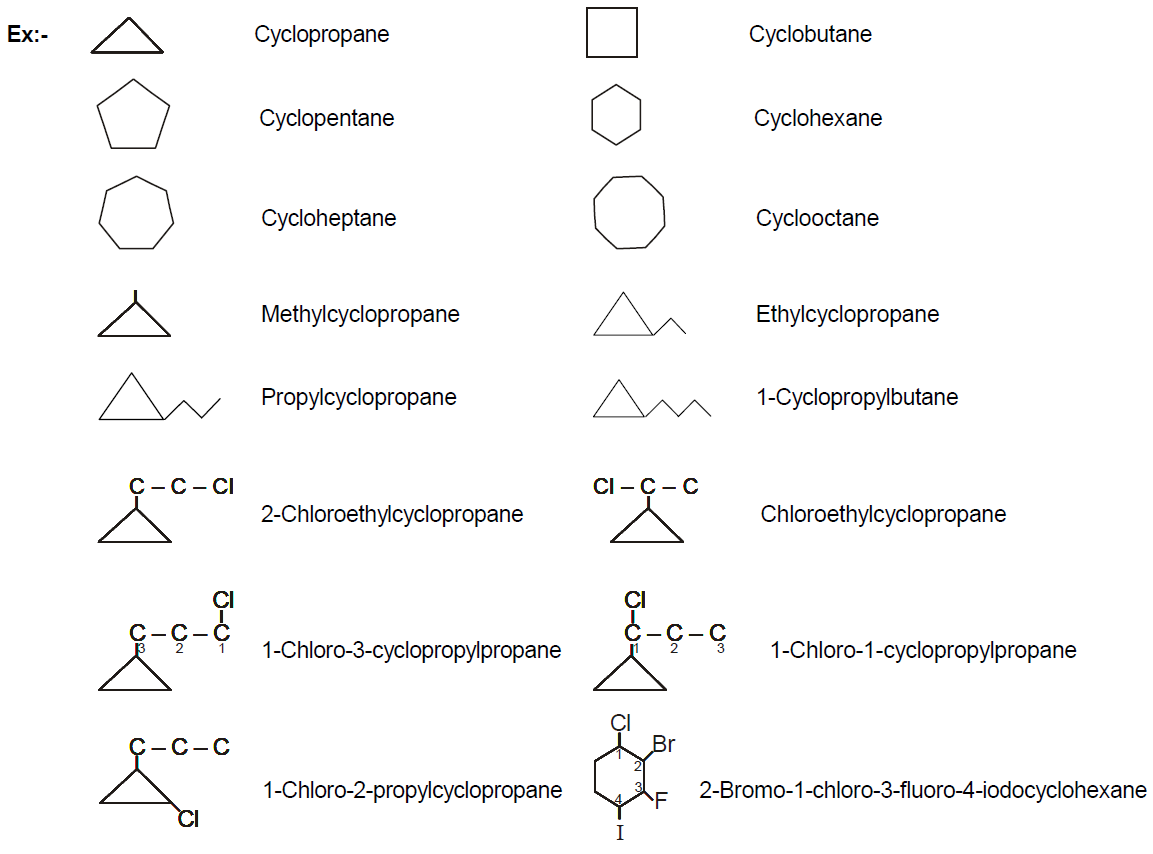
Naming of Cyclic Hydrocarbon (Alicyclic Compounds)
(A) Main Chain Selection :
(a)
(b) Agar cyclic aur acyclic part meh sabhi factors same ho then priority meh Cyclic > Acyclic.
(B) Numbering : Iske liye hum 2 rules follow karte hai :
(a) Lowest Locant rule
(b) Alphabetization
(C) Naming :
(a) Ab agar cyclic part main chain ka part ho toh tab hum prefix ‘cyclo’ use karte hai.
(b) Ab jab ye cyclic part main chain ka part hota hai tab hum prefix ‘cyclo’ ko alphabetical order ke liye consider nahi karte hai, lekin agar cyclic part side - chain ya substituent ho toh fir hum isse alphabetical order ke liye consider karte hai.
Some of the named examples are given below :

Naming of Cyclic Hydrocarbon (Alicyclic Compounds)
(A) Main Chain Selection :
(a)
(b) Agar cyclic aur acyclic part meh sabhi factors same ho then priority meh Cyclic > Acyclic.
(B) Numbering : Iske liye hum 2 rules follow karte hai :
(a) Lowest Locant rule
(b) Alphabetization
(C) Naming :
(a) Ab agar cyclic part main chain ka part ho toh tab hum prefix ‘cyclo’ use karte hai.
(b) Ab jab ye cyclic part main chain ka part hota hai tab hum prefix ‘cyclo’ ko alphabetical order ke liye consider nahi karte hai, lekin agar cyclic part side - chain ya substituent ho toh fir hum isse alphabetical order ke liye consider karte hai.
Some of the named examples are given below :

Naming of Cyclic Hydrocarbon (Alicyclic Compounds)
(A) Main Chain Selection :
(a)
(b) Agar cyclic aur acyclic part meh sabhi factors same ho then priority meh Cyclic > Acyclic.
(B) Numbering : Iske liye hum 2 rules follow karte hai :
(a) Lowest Locant rule
(b) Alphabetization
(C) Naming :
(a) Ab agar cyclic part main chain ka part ho toh tab hum prefix ‘cyclo’ use karte hai.
(b) Ab jab ye cyclic part main chain ka part hota hai tab hum prefix ‘cyclo’ ko alphabetical order ke liye consider nahi karte hai, lekin agar cyclic part side - chain ya substituent ho toh fir hum isse alphabetical order ke liye consider karte hai.
Some of the named examples are given below :

Naming of Cyclic Hydrocarbon (Alicyclic Compounds)
(A) Main Chain Selection :
(a)
(b) If all factors are similar in cyclic and acyclic part then Cyclic > Acyclic
(B) Numbering : For this we are using 2 rules :
(a) Lowest Locant rule
(b) Alphabetization
(C) Naming :
(a) Prefix ‘cyclo’ is used just before the word root if it constitutes the main chain.
(b) If the cyclic part is the main chain then the prefix ‘cyclo’ is not considered for alphabetical order. If the cyclic part constitutes the side - chain (substituent) then prefix ‘cyclo’ is considered for alphabetization.
Some of the named examples are given below :

Naming of Cyclic Hydrocarbon (Alicyclic Compounds)
(A) Main Chain Selection :
(a)
(b) If all factors are similar in cyclic and acyclic part then Cyclic > Acyclic
(B) Numbering : For this we are using 2 rules :
(a) Lowest Locant rule
(b) Alphabetization
(C) Naming :
(a) Prefix ‘cyclo’ is used just before the word root if it constitutes the main chain.
(b) If the cyclic part is the main chain then the prefix ‘cyclo’ is not considered for alphabetical order. If the cyclic part constitutes the side - chain (substituent) then prefix ‘cyclo’ is considered for alphabetization.
Some of the named examples are given below :

Naming of Cyclic Hydrocarbon (Alicyclic Compounds)
(A) Main Chain Selection :
(a)
(b) If all factors are similar in cyclic and acyclic part then Cyclic > Acyclic
(B) Numbering : For this we are using 2 rules :
(a) Lowest Locant rule
(b) Alphabetization
(C) Naming :
(a) Prefix ‘cyclo’ is used just before the word root if it constitutes the main chain.
(b) If the cyclic part is the main chain then the prefix ‘cyclo’ is not considered for alphabetical order. If the cyclic part constitutes the side - chain (substituent) then prefix ‘cyclo’ is considered for alphabetization.
Some of the named examples are given below :

Naming of Cyclic Hydrocarbon (Alicyclic Compounds)
(A) Main Chain Selection :
(a)
(b) If all factors are similar in cyclic and acyclic part then Cyclic > Acyclic
(B) Numbering : For this we are using 2 rules :
(a) Lowest Locant rule
(b) Alphabetization
(C) Naming :
(a) Prefix ‘cyclo’ is used just before the word root if it constitutes the main chain.
(b) If the cyclic part is the main chain then the prefix ‘cyclo’ is not considered for alphabetical order. If the cyclic part constitutes the side - chain (substituent) then prefix ‘cyclo’ is considered for alphabetization.
Some of the named examples are given below :

Hello Points!
Functional Group Table
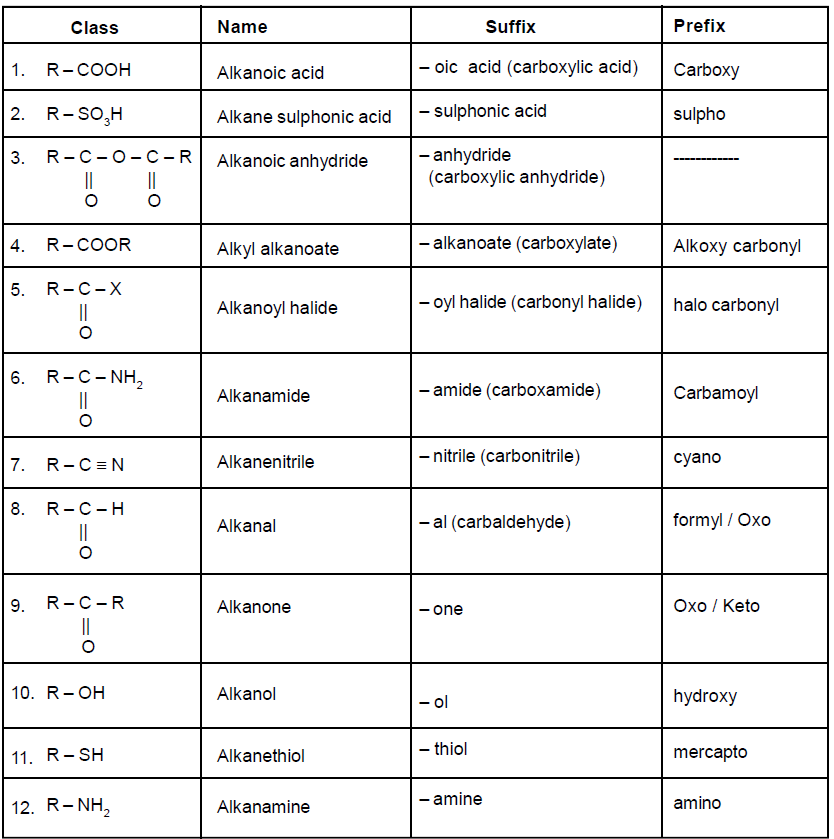
Hello Points!
Functional Group Table

Hello Points!
Functional Group Table

Hello Points!
Functional Group Table

Naming of Functional Group Containing Compounds
Selection of Main Chain :
Senior Functional Group > Maximum No. of Functional Group (Similar Group) > Multiple Bond > Maximum No. of Carbon Atoms > Maximum no. of locants > Lowest Locant > Alphabetization
Numbering (See Functional Group + Substituent) :
Jis carbon se functional group attached ho (or C−atom of terminal functional group) usse hum lowest possible number dete hai.
Lowest Locant - Functional Group > Multiple Bond > Substituent > Alphabetization
Naming : General Scheme :
Senior most functional group ko secondary suffix consider kiya jata hai. Other junior functional groups ko alphabetical order meh as prefix likha jata hai.
(A) Rules for Non Chain Terminating Functional Groups
Rule 1) Parent Chain Selection :
Sabse pehle hum longest chain select karte hai jisme maximum functional groups aur maximum saturation hoti hai.
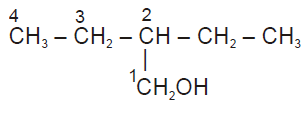
Rule 2) Numbering :
Numbering hamesha hum uss direction se karte hai jahan se principal functional group ko lowest locant milta hai. Functional group ke baad hum multiple bonds ko lowest locants ki preference dete hai.

(B) Rules for Chain Terminating Functional Groups
Rule 1 : Jab kabhi bhi chain terminating principal functional group carbon chain meh present ho tab hum isse hamesha number 1 mark karte hai.

Rule 2 : Agar kisi compound meh two or more similar groups hote hai toh tab hum di, tri, tetra, etc jaise numerical prefixes use karte hai.

Rule 3 : Benzene ka substituent name phenyl hota hai. In case phenyl ring further substituted ho tab carbon atom of the ring jo parent chain ke sath directly attached hota hai usko hum iss tarah numbered karte hai so that ring se substituted group ko sabse chota number mile.
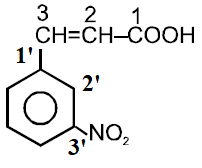
(C) IUPAC Names of Polyfunctional Compounds
Rule 1 : Jab kisi organic compound meh two or more functional groups hote hai toh senior functional group ko hum as a principal functional group select karte hai aur other groups ko hum as substituents treat karte hai.
Rule 2 : Kuch functional groups, jaise halo groups (bromo, chloro, fluoro, iodo), nitroso (NO), nitro (−NO2), aur alkoxy (−OR) ko hum hamesha as substituent groups treat karte hai.
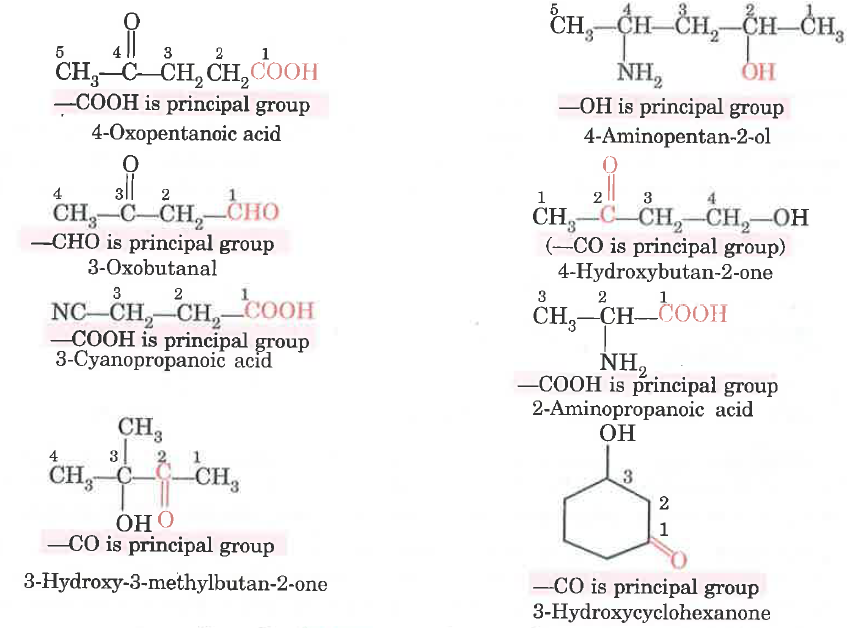
Naming of Functional Group Containing Compounds
Selection of Main Chain :
Senior Functional Group > Maximum No. of Functional Group (Similar Group) > Multiple Bond > Maximum No. of Carbon Atoms > Maximum no. of locants > Lowest Locant > Alphabetization
Numbering (See Functional Group + Substituent) :
Jis carbon se functional group attached ho (or C−atom of terminal functional group) usse hum lowest possible number dete hai.
Lowest Locant - Functional Group > Multiple Bond > Substituent > Alphabetization
Naming : General Scheme :
Senior most functional group ko secondary suffix consider kiya jata hai. Other junior functional groups ko alphabetical order meh as prefix likha jata hai.
(A) Rules for Non Chain Terminating Functional Groups
Rule 1) Parent Chain Selection :
Sabse pehle hum longest chain select karte hai jisme maximum functional groups aur maximum saturation hoti hai.

Rule 2) Numbering :
Numbering hamesha hum uss direction se karte hai jahan se principal functional group ko lowest locant milta hai. Functional group ke baad hum multiple bonds ko lowest locants ki preference dete hai.

(B) Rules for Chain Terminating Functional Groups
Rule 1 : Jab kabhi bhi chain terminating principal functional group carbon chain meh present ho tab hum isse hamesha number 1 mark karte hai.

Rule 2 : Agar kisi compound meh two or more similar groups hote hai toh tab hum di, tri, tetra, etc jaise numerical prefixes use karte hai.

Rule 3 : Benzene ka substituent name phenyl hota hai. In case phenyl ring further substituted ho tab carbon atom of the ring jo parent chain ke sath directly attached hota hai usko hum iss tarah numbered karte hai so that ring se substituted group ko sabse chota number mile.

(C) IUPAC Names of Polyfunctional Compounds
Rule 1 : Jab kisi organic compound meh two or more functional groups hote hai toh senior functional group ko hum as a principal functional group select karte hai aur other groups ko hum as substituents treat karte hai.
Rule 2 : Kuch functional groups, jaise halo groups (bromo, chloro, fluoro, iodo), nitroso (NO), nitro (−NO2), aur alkoxy (−OR) ko hum hamesha as substituent groups treat karte hai.

Naming of Functional Group Containing Compounds
Selection of Main Chain :
Senior Functional Group > Maximum No. of Functional Group (Similar Group) > Multiple Bond > Maximum No. of Carbon Atoms > Maximum no. of locants > Lowest Locant > Alphabetization
Numbering (See Functional Group + Substituent) :
Jis carbon se functional group attached ho (or C−atom of terminal functional group) usse hum lowest possible number dete hai.
Lowest Locant - Functional Group > Multiple Bond > Substituent > Alphabetization
Naming : General Scheme :
Senior most functional group ko secondary suffix consider kiya jata hai. Other junior functional groups ko alphabetical order meh as prefix likha jata hai.
(A) Rules for Non Chain Terminating Functional Groups
Rule 1) Parent Chain Selection :
Sabse pehle hum longest chain select karte hai jisme maximum functional groups aur maximum saturation hoti hai.

Rule 2) Numbering :
Numbering hamesha hum uss direction se karte hai jahan se principal functional group ko lowest locant milta hai. Functional group ke baad hum multiple bonds ko lowest locants ki preference dete hai.

(B) Rules for Chain Terminating Functional Groups
Rule 1 : Jab kabhi bhi chain terminating principal functional group carbon chain meh present ho tab hum isse hamesha number 1 mark karte hai.

Rule 2 : Agar kisi compound meh two or more similar groups hote hai toh tab hum di, tri, tetra, etc jaise numerical prefixes use karte hai.

Rule 3 : Benzene ka substituent name phenyl hota hai. In case phenyl ring further substituted ho tab carbon atom of the ring jo parent chain ke sath directly attached hota hai usko hum iss tarah numbered karte hai so that ring se substituted group ko sabse chota number mile.

(C) IUPAC Names of Polyfunctional Compounds
Rule 1 : Jab kisi organic compound meh two or more functional groups hote hai toh senior functional group ko hum as a principal functional group select karte hai aur other groups ko hum as substituents treat karte hai.
Rule 2 : Kuch functional groups, jaise halo groups (bromo, chloro, fluoro, iodo), nitroso (NO), nitro (−NO2), aur alkoxy (−OR) ko hum hamesha as substituent groups treat karte hai.

Naming of Functional Group Containing Compounds
Selection of Main Chain :
Senior Functional Group > Maximum No. of Functional Group (Similar Group) > Multiple Bond > Maximum No. of Carbon Atoms > Maximum no. of locants > Lowest Locant > Alphabetization
Numbering (See Functional Group + Substituent) :
Jis carbon se functional group attached ho (or C−atom of terminal functional group) usse hum lowest possible number dete hai.
Lowest Locant - Functional Group > Multiple Bond > Substituent > Alphabetization
Naming : General Scheme :
Senior most functional group ko secondary suffix consider kiya jata hai. Other junior functional groups ko alphabetical order meh as prefix likha jata hai.
(A) Rules for Non Chain Terminating Functional Groups
Rule 1) Parent Chain Selection :
Sabse pehle hum longest chain select karte hai jisme maximum functional groups aur maximum saturation hoti hai.

Rule 2) Numbering :
Numbering hamesha hum uss direction se karte hai jahan se principal functional group ko lowest locant milta hai. Functional group ke baad hum multiple bonds ko lowest locants ki preference dete hai.

(B) Rules for Chain Terminating Functional Groups
Rule 1 : Jab kabhi bhi chain terminating principal functional group carbon chain meh present ho tab hum isse hamesha number 1 mark karte hai.

Rule 2 : Agar kisi compound meh two or more similar groups hote hai toh tab hum di, tri, tetra, etc jaise numerical prefixes use karte hai.

Rule 3 : Benzene ka substituent name phenyl hota hai. In case phenyl ring further substituted ho tab carbon atom of the ring jo parent chain ke sath directly attached hota hai usko hum iss tarah numbered karte hai so that ring se substituted group ko sabse chota number mile.

(C) IUPAC Names of Polyfunctional Compounds
Rule 1 : Jab kisi organic compound meh two or more functional groups hote hai toh senior functional group ko hum as a principal functional group select karte hai aur other groups ko hum as substituents treat karte hai.
Rule 2 : Kuch functional groups, jaise halo groups (bromo, chloro, fluoro, iodo), nitroso (NO), nitro (−NO2), aur alkoxy (−OR) ko hum hamesha as substituent groups treat karte hai.

Naming of Functional Group Containing Compounds
Selection of Main Chain :
Senior Functional Group > Maximum No. of Functional Group (Similar Group) > Multiple Bond > Maximum No. of Carbon Atoms > Maximum no. of locants > Lowest Locant > Alphabetization
Numbering (See Functional Group + Substituent) :
The carbon atom bearing functional group (or C—atom of the terminal functional group) is given the lowest possible number.
Lowest Locant - Functional Group > Multiple Bond > Substituent > Alphabetization
Naming : General Scheme :
The senior most functional group constitutes the secondary suffix. Other Junior functional groups are written as prefixes in alphabetical order.
(A) Rules for Non Chain Terminating Functional Groups
Rule 1) Parent Chain Selection :
Select the longest possible chain with maximum functional groups and maximum unsaturation.

Rule 2) Numbering :
Numbering is done from that side of the chain which gives lowest locant to the principal functional group followed by double and triple bonds.

(B) Rules for Chain Terminating Functional Groups
Rule 1 : When a chain terminating principal functional group is present in the carbon chain, it is always given number one.

Rule 2 : If a compound contains two or more like groups the numerical prefixes di, tri, tetra etc are used.

Rule 3 : The name for benzene as a substituent is phenyl. In case the phenyl ring is further substituted, the carbon atom of the ring directly attached to the parent chain is numbered in such a way that the substituent on the ring gets the least possible number. For example

(C) IUPAC Names of Polyfunctional Compounds
Rule 1 : When an organic compound contains two or more different functional groups then senior functional group is selected as the principal functional group while other groups are treated as substituents.
Rule 2 : Some functional groups such as halo groups (bromo, chloro, fluoro, iodo), nitroso (NO), nitro (−NO2), and alkoxy (−OR) are always treated as substituent groups.

Naming of Functional Group Containing Compounds
Selection of Main Chain :
Senior Functional Group > Maximum No. of Functional Group (Similar Group) > Multiple Bond > Maximum No. of Carbon Atoms > Maximum no. of locants > Lowest Locant > Alphabetization
Numbering (See Functional Group + Substituent) :
The carbon atom bearing functional group (or C—atom of the terminal functional group) is given the lowest possible number.
Lowest Locant - Functional Group > Multiple Bond > Substituent > Alphabetization
Naming : General Scheme :
The senior most functional group constitutes the secondary suffix. Other Junior functional groups are written as prefixes in alphabetical order.
(A) Rules for Non Chain Terminating Functional Groups
Rule 1) Parent Chain Selection :
Select the longest possible chain with maximum functional groups and maximum unsaturation.

Rule 2) Numbering :
Numbering is done from that side of the chain which gives lowest locant to the principal functional group followed by double and triple bonds.

(B) Rules for Chain Terminating Functional Groups
Rule 1 : When a chain terminating principal functional group is present in the carbon chain, it is always given number one.

Rule 2 : If a compound contains two or more like groups the numerical prefixes di, tri, tetra etc are used.

Rule 3 : The name for benzene as a substituent is phenyl. In case the phenyl ring is further substituted, the carbon atom of the ring directly attached to the parent chain is numbered in such a way that the substituent on the ring gets the least possible number. For example

(C) IUPAC Names of Polyfunctional Compounds
Rule 1 : When an organic compound contains two or more different functional groups then senior functional group is selected as the principal functional group while other groups are treated as substituents.
Rule 2 : Some functional groups such as halo groups (bromo, chloro, fluoro, iodo), nitroso (NO), nitro (−NO2), and alkoxy (−OR) are always treated as substituent groups.

Naming of Functional Group Containing Compounds
Selection of Main Chain :
Senior Functional Group > Maximum No. of Functional Group (Similar Group) > Multiple Bond > Maximum No. of Carbon Atoms > Maximum no. of locants > Lowest Locant > Alphabetization
Numbering (See Functional Group + Substituent) :
The carbon atom bearing functional group (or C—atom of the terminal functional group) is given the lowest possible number.
Lowest Locant - Functional Group > Multiple Bond > Substituent > Alphabetization
Naming : General Scheme :
The senior most functional group constitutes the secondary suffix. Other Junior functional groups are written as prefixes in alphabetical order.
(A) Rules for Non Chain Terminating Functional Groups
Rule 1) Parent Chain Selection :
Select the longest possible chain with maximum functional groups and maximum unsaturation.

Rule 2) Numbering :
Numbering is done from that side of the chain which gives lowest locant to the principal functional group followed by double and triple bonds.

(B) Rules for Chain Terminating Functional Groups
Rule 1 : When a chain terminating principal functional group is present in the carbon chain, it is always given number one.

Rule 2 : If a compound contains two or more like groups the numerical prefixes di, tri, tetra etc are used.

Rule 3 : The name for benzene as a substituent is phenyl. In case the phenyl ring is further substituted, the carbon atom of the ring directly attached to the parent chain is numbered in such a way that the substituent on the ring gets the least possible number. For example

(C) IUPAC Names of Polyfunctional Compounds
Rule 1 : When an organic compound contains two or more different functional groups then senior functional group is selected as the principal functional group while other groups are treated as substituents.
Rule 2 : Some functional groups such as halo groups (bromo, chloro, fluoro, iodo), nitroso (NO), nitro (−NO2), and alkoxy (−OR) are always treated as substituent groups.

Naming of Functional Group Containing Compounds
Selection of Main Chain :
Senior Functional Group > Maximum No. of Functional Group (Similar Group) > Multiple Bond > Maximum No. of Carbon Atoms > Maximum no. of locants > Lowest Locant > Alphabetization
Numbering (See Functional Group + Substituent) :
The carbon atom bearing functional group (or C—atom of the terminal functional group) is given the lowest possible number.
Lowest Locant - Functional Group > Multiple Bond > Substituent > Alphabetization
Naming : General Scheme :
The senior most functional group constitutes the secondary suffix. Other Junior functional groups are written as prefixes in alphabetical order.
(A) Rules for Non Chain Terminating Functional Groups
Rule 1) Parent Chain Selection :
Select the longest possible chain with maximum functional groups and maximum unsaturation.

Rule 2) Numbering :
Numbering is done from that side of the chain which gives lowest locant to the principal functional group followed by double and triple bonds.

(B) Rules for Chain Terminating Functional Groups
Rule 1 : When a chain terminating principal functional group is present in the carbon chain, it is always given number one.

Rule 2 : If a compound contains two or more like groups the numerical prefixes di, tri, tetra etc are used.

Rule 3 : The name for benzene as a substituent is phenyl. In case the phenyl ring is further substituted, the carbon atom of the ring directly attached to the parent chain is numbered in such a way that the substituent on the ring gets the least possible number. For example

(C) IUPAC Names of Polyfunctional Compounds
Rule 1 : When an organic compound contains two or more different functional groups then senior functional group is selected as the principal functional group while other groups are treated as substituents.
Rule 2 : Some functional groups such as halo groups (bromo, chloro, fluoro, iodo), nitroso (NO), nitro (−NO2), and alkoxy (−OR) are always treated as substituent groups.

Different Functional Groups their IUPAC Naming and Examples
1) Sulphonic Acid :

Some of the named examples are given below :
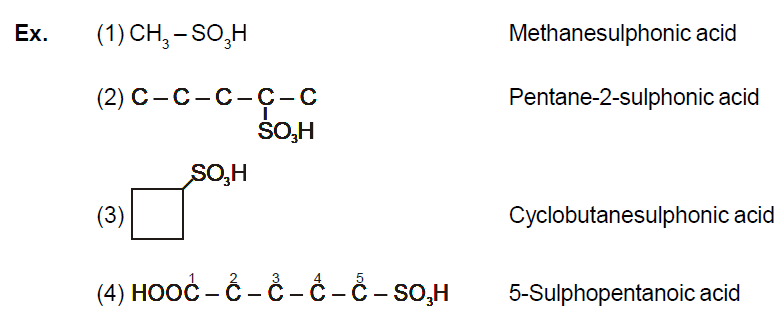
2) Ketone :

Some of the named examples are given below :
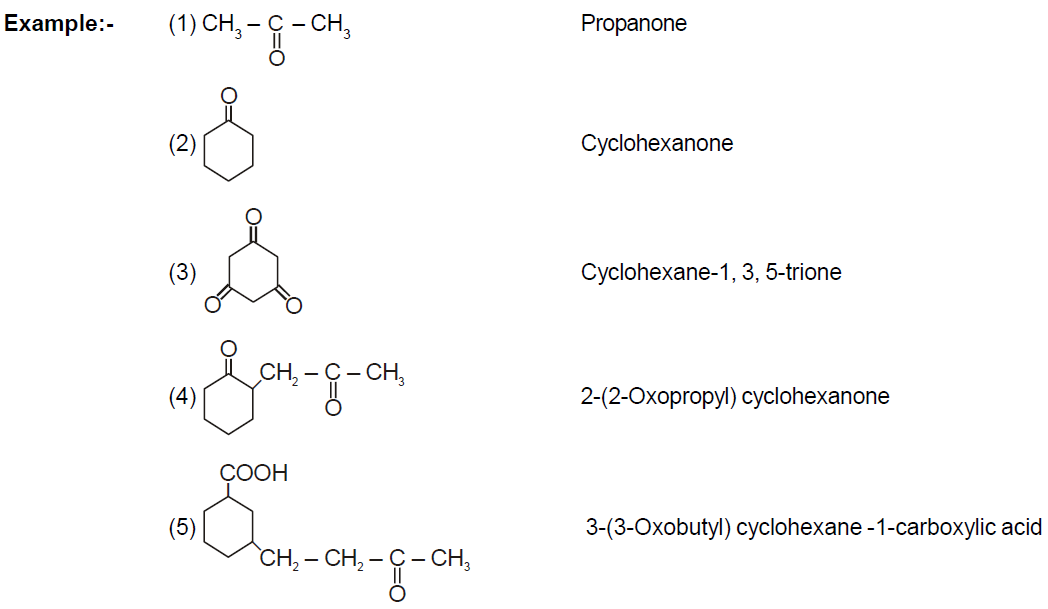
3) Alcohol :

Some of the named examples are given below :
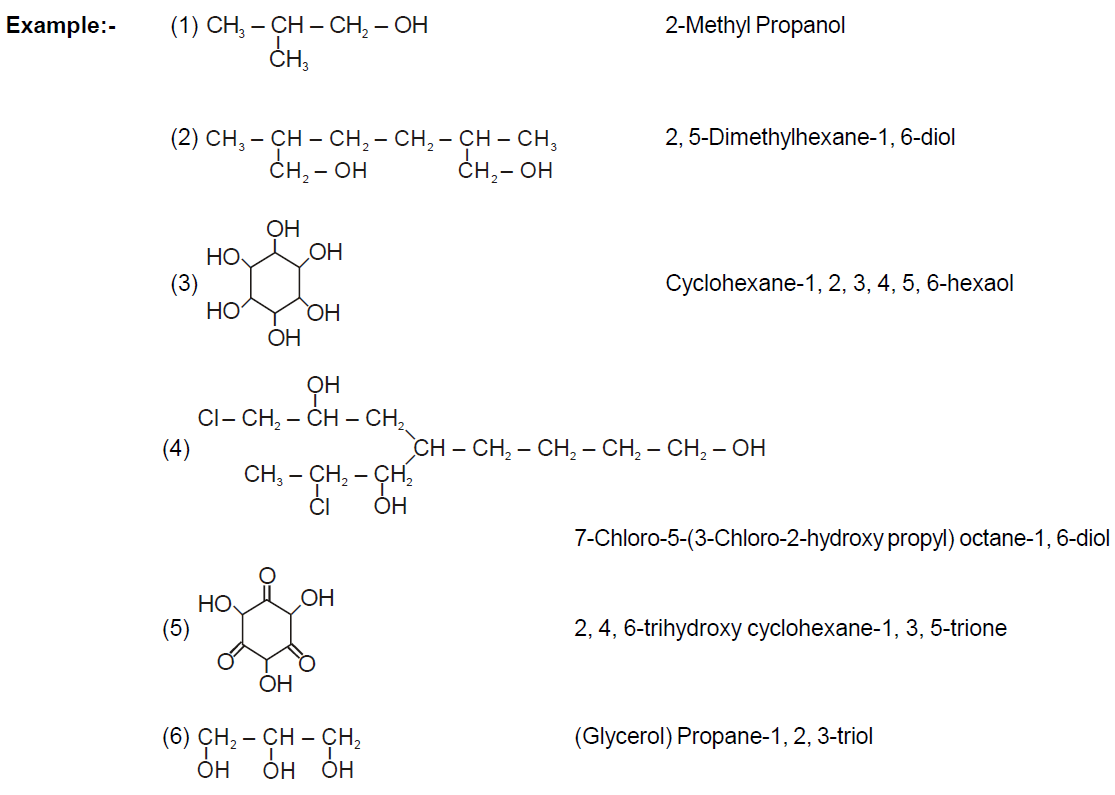
4) Thiol :

Some of the named examples are given below :
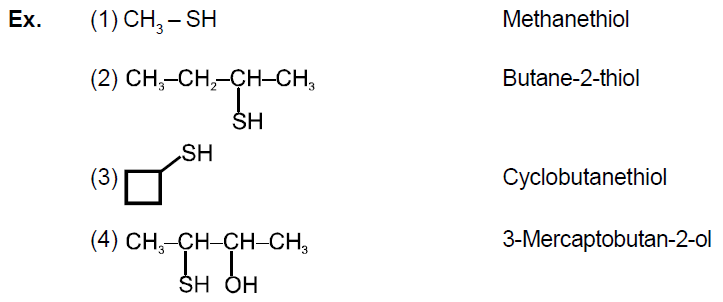
5) Amines :
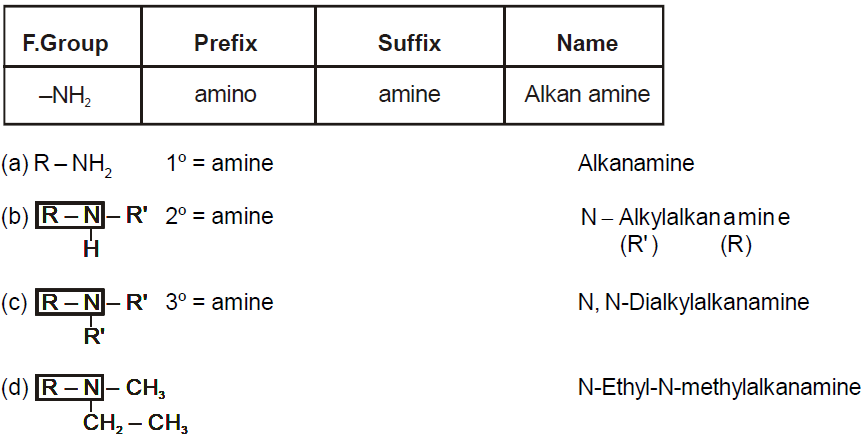
Some of the named examples are given below :
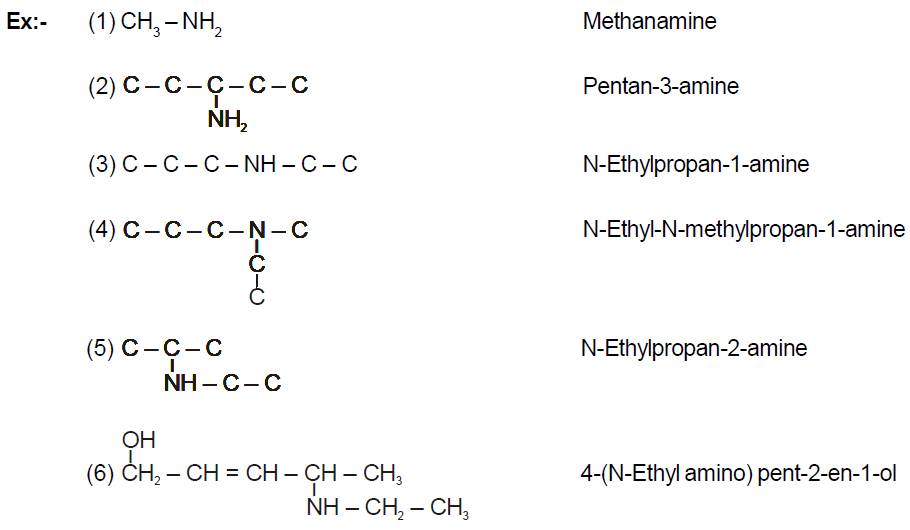
6) Ethers :

These are derived from alkanes by replacing one hydrogen atom by alkoxy group (−OR). In an ether molecule, two alkyl radicals are linked on either sides to a divalent oxygen atom (−O−). They are called simple ethers if R=R' and mixed ethers if R and R' are different. Here, the alkoxy group is taken with smaller alkyl group.
(i) Acyclic Ethers : For example

∗ In cyclic system, numbering always starts from senior most functional group.

(ii) Cyclic Ethers :
Heterocyclic compounds : For example
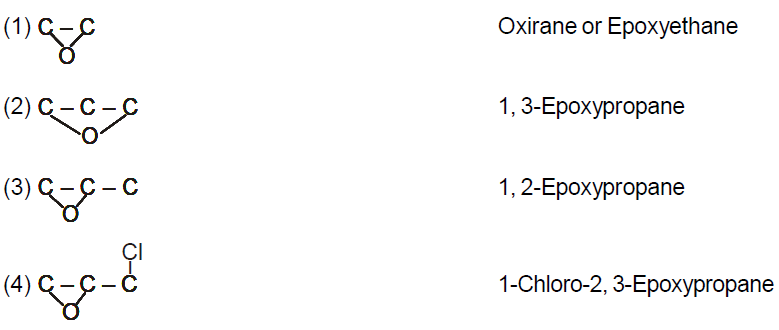
7) Hetero Atom Containing Compound :
If hetero atom's are count as a C atom in the parent chain then they are written as :
(i) −NH− → Aza
(ii) −O− → Oxa
(iii) −S− → Thia
(iv) −Se → Selena
Some of the named examples are given below :
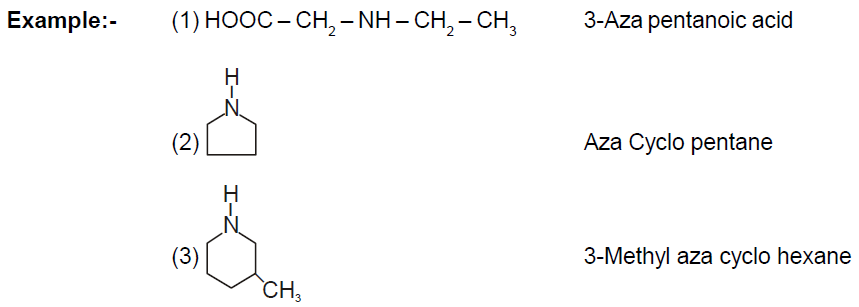
Polyethers :
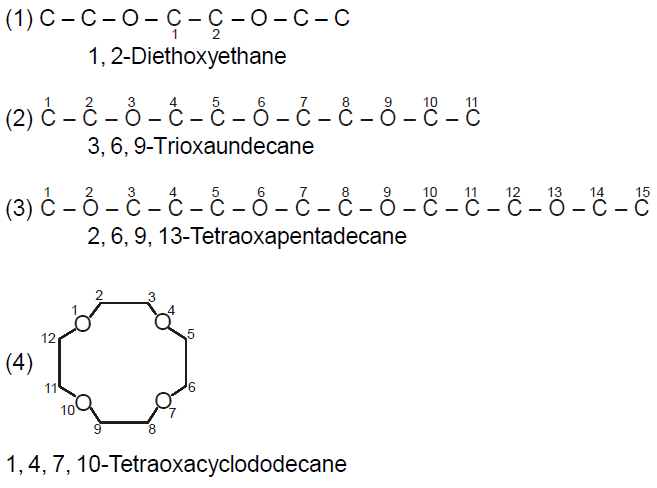
8) Carboxylic Acid :

Rule : If first alphabet of sec. suffix is begin from a,i,o,u,y then e of primary suffix will be dropped.
Some of the named examples are given below :
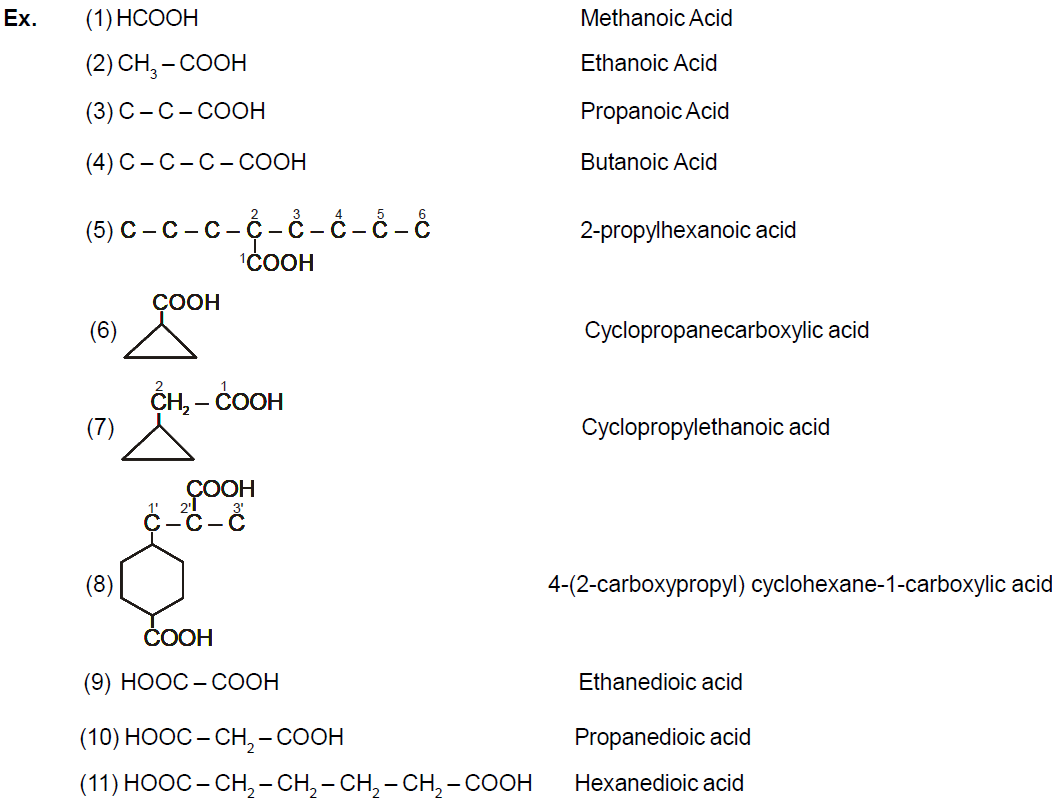
9) Acid Halide :

Some of the named examples are given below :
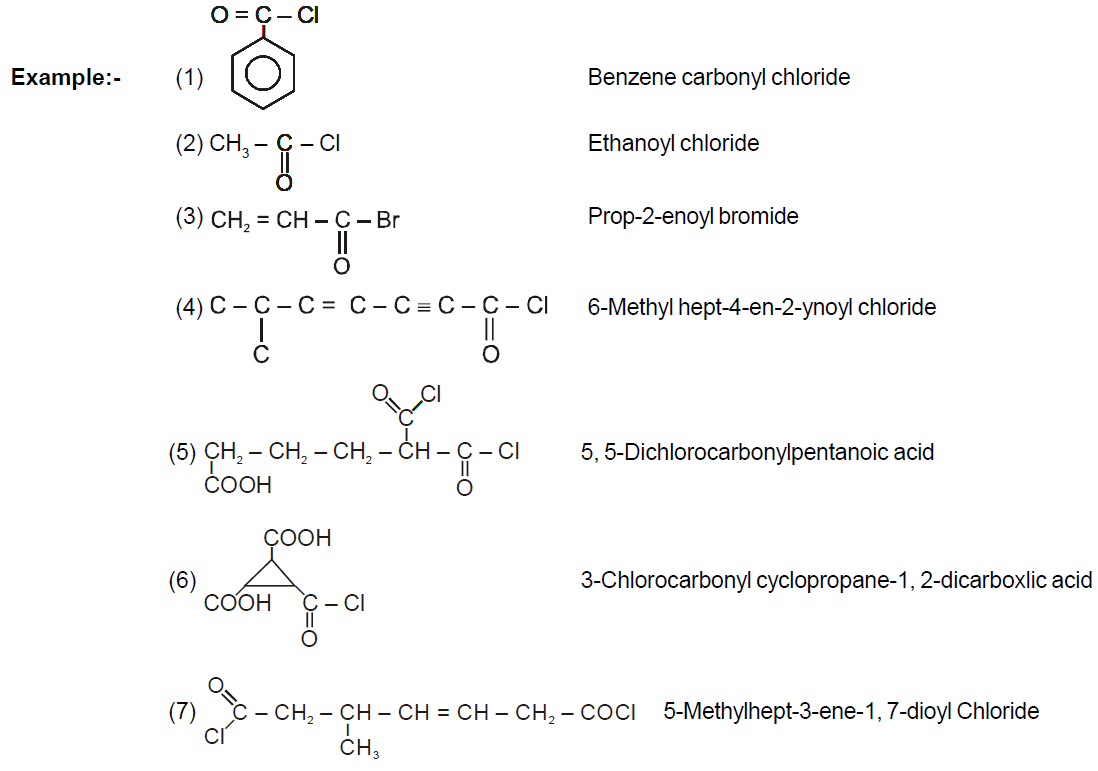
10) Nitriles :

Some of the named examples are given below :
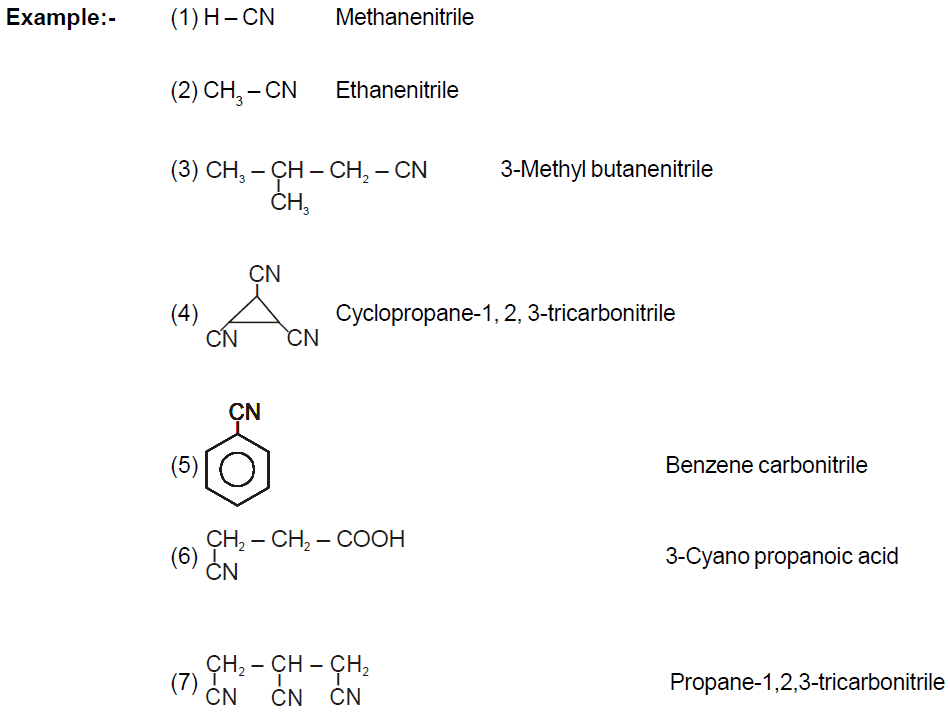
11) Isocyanides :

Some of the named examples are given below :

12) Aldehydes :

Some of the named examples are given below :
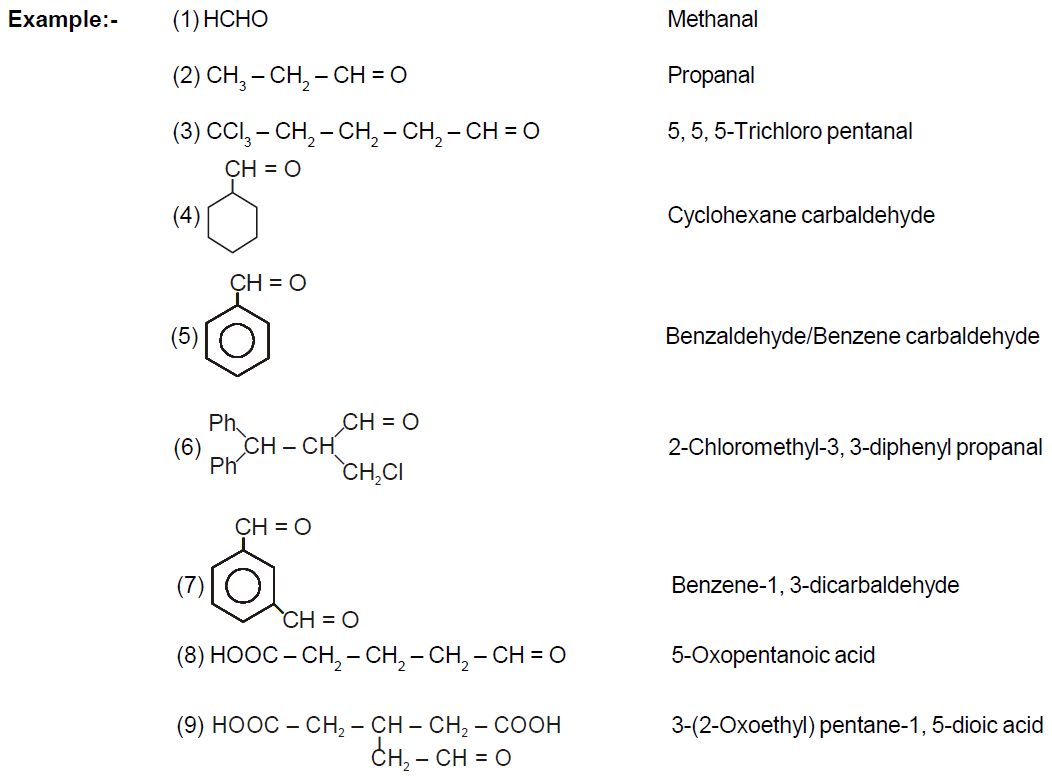
13) Anhydride :

Preparation :

Some of the named examples are given below :

14) Ester :

Preparation :

Some of the named examples are given below :

15) Amide :

Some of the named examples are given below :
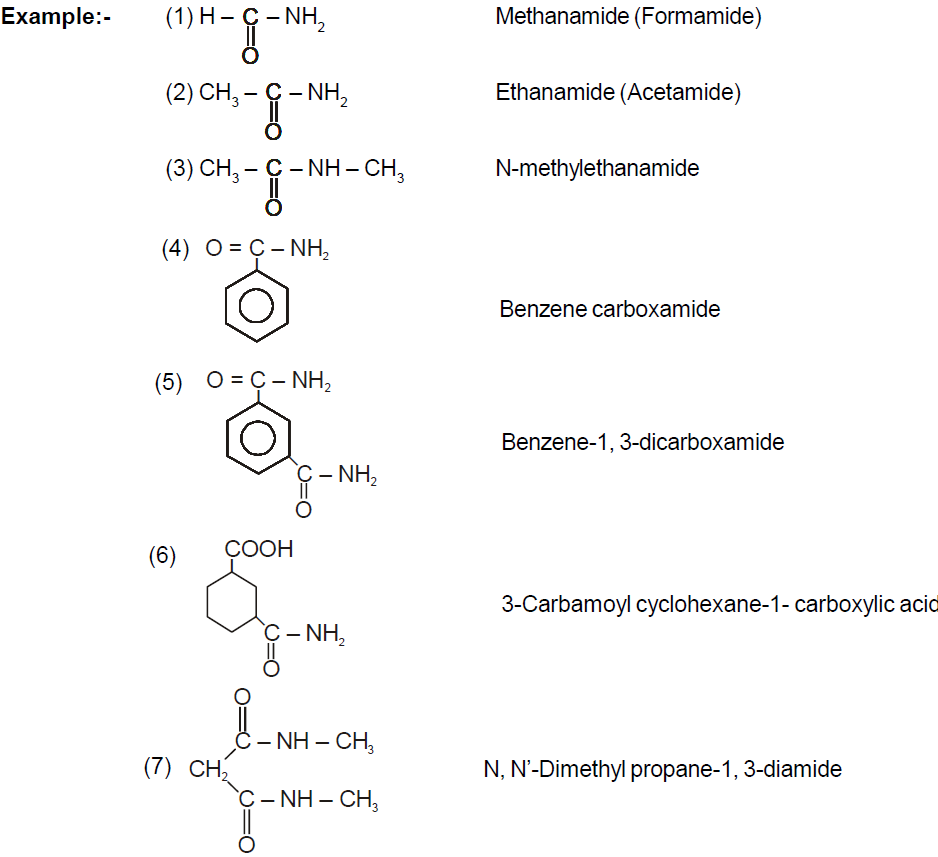
Different Functional Groups their IUPAC Naming and Examples
1) Sulphonic Acid :

Some of the named examples are given below :

2) Ketone :

Some of the named examples are given below :

3) Alcohol :

Some of the named examples are given below :

4) Thiol :

Some of the named examples are given below :

5) Amines :

Some of the named examples are given below :

6) Ethers :

These are derived from alkanes by replacing one hydrogen atom by alkoxy group (−OR). In an ether molecule, two alkyl radicals are linked on either sides to a divalent oxygen atom (−O−). They are called simple ethers if R=R' and mixed ethers if R and R' are different. Here, the alkoxy group is taken with smaller alkyl group.
(i) Acyclic Ethers : For example

∗ In cyclic system, numbering always starts from senior most functional group.

(ii) Cyclic Ethers :
Heterocyclic compounds : For example

7) Hetero Atom Containing Compound :
If hetero atom's are count as a C atom in the parent chain then they are written as :
(i) −NH− → Aza
(ii) −O− → Oxa
(iii) −S− → Thia
(iv) −Se → Selena
Some of the named examples are given below :

Polyethers :

8) Carboxylic Acid :

Rule : If first alphabet of sec. suffix is begin from a,i,o,u,y then e of primary suffix will be dropped.
Some of the named examples are given below :

9) Acid Halide :

Some of the named examples are given below :

10) Nitriles :

Some of the named examples are given below :

11) Isocyanides :

Some of the named examples are given below :

12) Aldehydes :

Some of the named examples are given below :

13) Anhydride :

Preparation :

Some of the named examples are given below :

14) Ester :

Preparation :

Some of the named examples are given below :

15) Amide :

Some of the named examples are given below :

Different Functional Groups their IUPAC Naming and Examples
1) Sulphonic Acid :

Some of the named examples are given below :

2) Ketone :

Some of the named examples are given below :

3) Alcohol :

Some of the named examples are given below :

4) Thiol :

Some of the named examples are given below :

5) Amines :

Some of the named examples are given below :

6) Ethers :

These are derived from alkanes by replacing one hydrogen atom by alkoxy group (−OR). In an ether molecule, two alkyl radicals are linked on either sides to a divalent oxygen atom (−O−). They are called simple ethers if R=R' and mixed ethers if R and R' are different. Here, the alkoxy group is taken with smaller alkyl group.
(i) Acyclic Ethers : For example

∗ In cyclic system, numbering always starts from senior most functional group.

(ii) Cyclic Ethers :
Heterocyclic compounds : For example

7) Hetero Atom Containing Compound :
If hetero atom's are count as a C atom in the parent chain then they are written as :
(i) −NH− → Aza
(ii) −O− → Oxa
(iii) −S− → Thia
(iv) −Se → Selena
Some of the named examples are given below :

Polyethers :

8) Carboxylic Acid :

Rule : If first alphabet of sec. suffix is begin from a,i,o,u,y then e of primary suffix will be dropped.
Some of the named examples are given below :

9) Acid Halide :

Some of the named examples are given below :

10) Nitriles :

Some of the named examples are given below :

11) Isocyanides :

Some of the named examples are given below :

12) Aldehydes :

Some of the named examples are given below :

13) Anhydride :

Preparation :

Some of the named examples are given below :

14) Ester :

Preparation :

Some of the named examples are given below :

15) Amide :

Some of the named examples are given below :

Different Functional Groups their IUPAC Naming and Examples
1) Sulphonic Acid :

Some of the named examples are given below :

2) Ketone :

Some of the named examples are given below :

3) Alcohol :

Some of the named examples are given below :

4) Thiol :

Some of the named examples are given below :

5) Amines :

Some of the named examples are given below :

6) Ethers :

These are derived from alkanes by replacing one hydrogen atom by alkoxy group (−OR). In an ether molecule, two alkyl radicals are linked on either sides to a divalent oxygen atom (−O−). They are called simple ethers if R=R' and mixed ethers if R and R' are different. Here, the alkoxy group is taken with smaller alkyl group.
(i) Acyclic Ethers : For example

∗ In cyclic system, numbering always starts from senior most functional group.

(ii) Cyclic Ethers :
Heterocyclic compounds : For example

7) Hetero Atom Containing Compound :
If hetero atom's are count as a C atom in the parent chain then they are written as :
(i) −NH− → Aza
(ii) −O− → Oxa
(iii) −S− → Thia
(iv) −Se → Selena
Some of the named examples are given below :

Polyethers :

8) Carboxylic Acid :

Rule : If first alphabet of sec. suffix is begin from a,i,o,u,y then e of primary suffix will be dropped.
Some of the named examples are given below :

9) Acid Halide :

Some of the named examples are given below :

10) Nitriles :

Some of the named examples are given below :

11) Isocyanides :

Some of the named examples are given below :

12) Aldehydes :

Some of the named examples are given below :

13) Anhydride :

Preparation :

Some of the named examples are given below :

14) Ester :

Preparation :

Some of the named examples are given below :

15) Amide :

Some of the named examples are given below :

EXAMPLE 3
Indicate the following as 1∘,2∘ & 3∘ amines.
(a) 2∘ - surrounded by 2 carbons
(b) 2∘ - surrounded by 2 carbons
(c) 3∘ surrounded by 3 carbons
(d) 3∘ - surrounded by 3 carbons
EXAMPLE 3
Indicate the following as 1∘,2∘ & 3∘ amines.
(a) 2∘ - surrounded by 2 carbons
(b) 2∘ - surrounded by 2 carbons
(c) 3∘ surrounded by 3 carbons
(d) 3∘ - surrounded by 3 carbons
EXAMPLE 3
Indicate the following as 1∘,2∘ & 3∘ amines.
(a) 2∘ - surrounded by 2 carbons
(b) 2∘ - surrounded by 2 carbons
(c) 3∘ surrounded by 3 carbons
(d) 3∘ - surrounded by 3 carbons
EXAMPLE 3
Indicate the following as 1∘,2∘ & 3∘ amines.
(a) 2∘ - surrounded by 2 carbons
(b) 2∘ - surrounded by 2 carbons
(c) 3∘ surrounded by 3 carbons
(d) 3∘ - surrounded by 3 carbons
EXAMPLE 4
Write the correct IUPAC name of the following :
(i) 
The correct IUPAC name of the following compounds are :
(i) 3−Bromo−2−methylbutanal
(ii) 4−Bromo−4−chlorobutan−2−one
EXAMPLE 4
Write the correct IUPAC name of the following :
(i) 
The correct IUPAC name of the following compounds are :
(i) 3−Bromo−2−methylbutanal
(ii) 4−Bromo−4−chlorobutan−2−one
EXAMPLE 4
Write the correct IUPAC name of the following :
(i) 
The correct IUPAC name of the following compounds are :
(i) 3−Bromo−2−methylbutanal
(ii) 4−Bromo−4−chlorobutan−2−one
EXAMPLE 4
Write the correct IUPAC name of the following :
(i) 
The correct IUPAC name of the following compounds are :
(i) 3−Bromo−2−methylbutanal
(ii) 4−Bromo−4−chlorobutan−2−one
EXAMPLE 5
Give the IUPAC names of :
(i) CH3O−CH2−CH2−OCH3 (ii) CH3−CH∣OH−CH=CH2
The IUPAC names of the given compounds are :
(i) 1,2−Dimethoxyethane
(ii) But−3−en−2−ol.
EXAMPLE 5
Give the IUPAC names of :
(i) CH3O−CH2−CH2−OCH3 (ii) CH3−CH∣OH−CH=CH2
The IUPAC names of the given compounds are :
(i) 1,2−Dimethoxyethane
(ii) But−3−en−2−ol.
EXAMPLE 5
Give the IUPAC names of :
(i) CH3O−CH2−CH2−OCH3 (ii) CH3−CH∣OH−CH=CH2
The IUPAC names of the given compounds are :
(i) 1,2−Dimethoxyethane
(ii) But−3−en−2−ol.
EXAMPLE 5
Give the IUPAC names of :
(i) CH3O−CH2−CH2−OCH3 (ii) CH3−CH∣OH−CH=CH2
The IUPAC names of the given compounds are :
(i) 1,2−Dimethoxyethane
(ii) But−3−en−2−ol.
EXAMPLE 6
Write the IUPAC name of the following compound :
H3C−Cl∣CH−CH2−O∣∣C−CH3
The IUPAC name of the following compound is 4−Chloropentan−2−one
EXAMPLE 6
Write the IUPAC name of the following compound :
H3C−Cl∣CH−CH2−O∣∣C−CH3
The IUPAC name of the following compound is 4−Chloropentan−2−one
EXAMPLE 6
Write the IUPAC name of the following compound :
H3C−Cl∣CH−CH2−O∣∣C−CH3
The IUPAC name of the following compound is 4−Chloropentan−2−one
EXAMPLE 6
Write the IUPAC name of the following compound :
H3C−Cl∣CH−CH2−O∣∣C−CH3
The IUPAC name of the following compound is 4−Chloropentan−2−one
EXAMPLE 7
The IUPAC name of the compound
CH3−CH∣OH−CH∣OH−CH2∣OH is
The IUPAC name of the compound is Butane−1,2,3−triol.
EXAMPLE 7
The IUPAC name of the compound
CH3−CH∣OH−CH∣OH−CH2∣OH is
The IUPAC name of the compound is Butane−1,2,3−triol.
EXAMPLE 7
The IUPAC name of the compound
CH3−CH∣OH−CH∣OH−CH2∣OH is
The IUPAC name of the compound is Butane−1,2,3−triol.
EXAMPLE 7
The IUPAC name of the compound
CH3−CH∣OH−CH∣OH−CH2∣OH is
The IUPAC name of the compound is Butane−1,2,3−triol.
EXAMPLE 8
Give the IUPAC name of the compound : CH3−C∣CH3=C∣Br−CH2OH.
The IUPAC name of the given compound is
4CH3−3C∣CH3=2C∣Br−1CH2OH
2−Bromo−3−methylbut−2−en−1−ol.
EXAMPLE 8
Give the IUPAC name of the compound : CH3−C∣CH3=C∣Br−CH2OH.
The IUPAC name of the given compound is
4CH3−3C∣CH3=2C∣Br−1CH2OH
2−Bromo−3−methylbut−2−en−1−ol.
EXAMPLE 8
Give the IUPAC name of the compound : CH3−C∣CH3=C∣Br−CH2OH.
The IUPAC name of the given compound is
4CH3−3C∣CH3=2C∣Br−1CH2OH
2−Bromo−3−methylbut−2−en−1−ol.
EXAMPLE 8
Give the IUPAC name of the compound : CH3−C∣CH3=C∣Br−CH2OH.
The IUPAC name of the given compound is
4CH3−3C∣CH3=2C∣Br−1CH2OH
2−Bromo−3−methylbut−2−en−1−ol.
Aromatic Compounds
Jab hum substituted benzene compounds ka IUPAC nomenclature karte hai tab substituent ko hum as prefix use karte hai to the word benzene as shown below. However, many substituted benzene compounds ke common name (in bracket) bhi universally used hote hai.
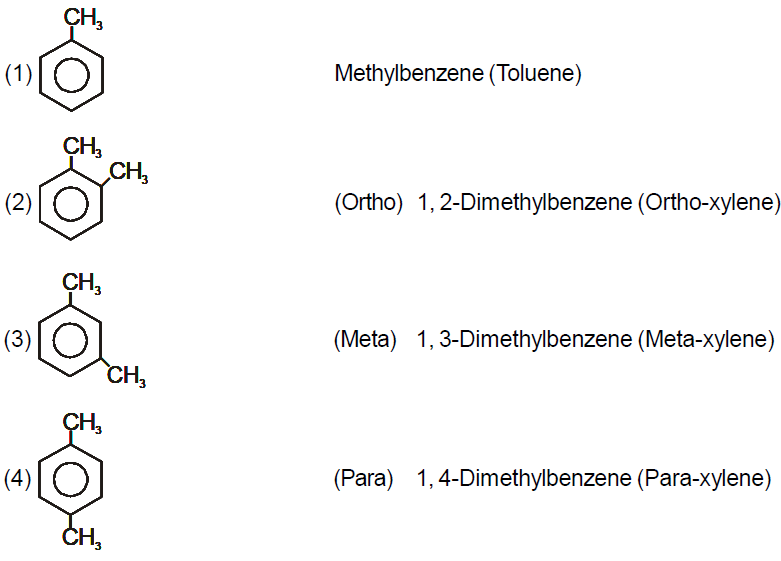
Trialkyl Substituted Benzene
Agar teeno substituents similar hote hai toh tabhi sirf 3 trisubstituted benzene derivatives possible hote hai.

Aromatic compounds meh do ya do se jayda benzene rings fused bhi ho sakti hai.

Aromatic Compounds
Jab hum substituted benzene compounds ka IUPAC nomenclature karte hai tab substituent ko hum as prefix use karte hai to the word benzene as shown below. However, many substituted benzene compounds ke common name (in bracket) bhi universally used hote hai.

Trialkyl Substituted Benzene
Agar teeno substituents similar hote hai toh tabhi sirf 3 trisubstituted benzene derivatives possible hote hai.

Aromatic compounds meh do ya do se jayda benzene rings fused bhi ho sakti hai.

Aromatic Compounds
Jab hum substituted benzene compounds ka IUPAC nomenclature karte hai tab substituent ko hum as prefix use karte hai to the word benzene as shown below. However, many substituted benzene compounds ke common name (in bracket) bhi universally used hote hai.

Trialkyl Substituted Benzene
Agar teeno substituents similar hote hai toh tabhi sirf 3 trisubstituted benzene derivatives possible hote hai.

Aromatic compounds meh do ya do se jayda benzene rings fused bhi ho sakti hai.

Aromatic Compounds
Jab hum substituted benzene compounds ka IUPAC nomenclature karte hai tab substituent ko hum as prefix use karte hai to the word benzene as shown below. However, many substituted benzene compounds ke common name (in bracket) bhi universally used hote hai.

Trialkyl Substituted Benzene
Agar teeno substituents similar hote hai toh tabhi sirf 3 trisubstituted benzene derivatives possible hote hai.

Aromatic compounds meh do ya do se jayda benzene rings fused bhi ho sakti hai.

Aromatic Compounds
For IUPAC nomenclature of substituted benzene compounds, the substituent is placed as prefix to the word benzene as shown in the following examples. However, common names (written in bracket below) of many substituted benzene compounds are also universally used.

Trialkyl Substituted Benzene
If all the three substituents are similar, then only 3 trisubstituted benzene derivative are possible.

In aromatic compounds, two or more than two benzene rings can be fused also.

Aromatic Compounds
For IUPAC nomenclature of substituted benzene compounds, the substituent is placed as prefix to the word benzene as shown in the following examples. However, common names (written in bracket below) of many substituted benzene compounds are also universally used.

Trialkyl Substituted Benzene
If all the three substituents are similar, then only 3 trisubstituted benzene derivative are possible.

In aromatic compounds, two or more than two benzene rings can be fused also.

Aromatic Compounds
For IUPAC nomenclature of substituted benzene compounds, the substituent is placed as prefix to the word benzene as shown in the following examples. However, common names (written in bracket below) of many substituted benzene compounds are also universally used.

Trialkyl Substituted Benzene
If all the three substituents are similar, then only 3 trisubstituted benzene derivative are possible.

In aromatic compounds, two or more than two benzene rings can be fused also.

Aromatic Compounds
For IUPAC nomenclature of substituted benzene compounds, the substituent is placed as prefix to the word benzene as shown in the following examples. However, common names (written in bracket below) of many substituted benzene compounds are also universally used.

Trialkyl Substituted Benzene
If all the three substituents are similar, then only 3 trisubstituted benzene derivative are possible.

In aromatic compounds, two or more than two benzene rings can be fused also.

Calculation of Degree of Unsaturation (DU)
(a) Ye hydrogen deficiency index (HDI) ya double bond equivalence (DBE) hota hai.
(b)

Iska matlab 2 Hydrogens ki deficiency 1 DU ke equivalent hoti hai.
(c) 1 DU = Ek double bond ki presence or ek ring closure ki presence hoti hai.
2 DU = Two Double bond or 1 Triple Bond or 2 Ring Closure or 1 Double Bond + 1 Ring ki presence hoti hai.
(d) General formula for some compounds in order to find their double bond equivalence (DBE).
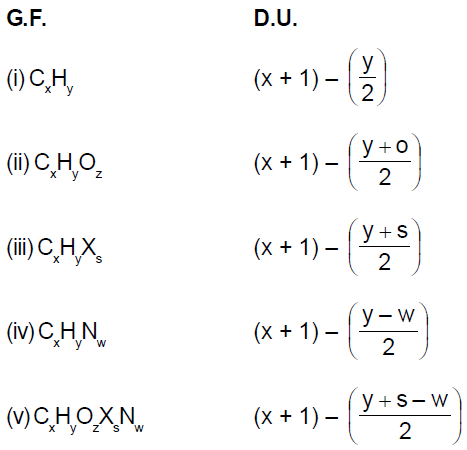
Note : Aromatic compounds ke case meh minimum DU =4 hoti hai iska matlab ki inme atleast 1 benzene ring present hoti hai.
Calculation of Degree of Unsaturation (DU)
(a) Ye hydrogen deficiency index (HDI) ya double bond equivalence (DBE) hota hai.
(b)

Iska matlab 2 Hydrogens ki deficiency 1 DU ke equivalent hoti hai.
(c) 1 DU = Ek double bond ki presence or ek ring closure ki presence hoti hai.
2 DU = Two Double bond or 1 Triple Bond or 2 Ring Closure or 1 Double Bond + 1 Ring ki presence hoti hai.
(d) General formula for some compounds in order to find their double bond equivalence (DBE).

Note : Aromatic compounds ke case meh minimum DU =4 hoti hai iska matlab ki inme atleast 1 benzene ring present hoti hai.
Calculation of Degree of Unsaturation (DU)
(a) Ye hydrogen deficiency index (HDI) ya double bond equivalence (DBE) hota hai.
(b)

Iska matlab 2 Hydrogens ki deficiency 1 DU ke equivalent hoti hai.
(c) 1 DU = Ek double bond ki presence or ek ring closure ki presence hoti hai.
2 DU = Two Double bond or 1 Triple Bond or 2 Ring Closure or 1 Double Bond + 1 Ring ki presence hoti hai.
(d) General formula for some compounds in order to find their double bond equivalence (DBE).

Note : Aromatic compounds ke case meh minimum DU =4 hoti hai iska matlab ki inme atleast 1 benzene ring present hoti hai.
Calculation of Degree of Unsaturation (DU)
(a) Ye hydrogen deficiency index (HDI) ya double bond equivalence (DBE) hota hai.
(b)

Iska matlab 2 Hydrogens ki deficiency 1 DU ke equivalent hoti hai.
(c) 1 DU = Ek double bond ki presence or ek ring closure ki presence hoti hai.
2 DU = Two Double bond or 1 Triple Bond or 2 Ring Closure or 1 Double Bond + 1 Ring ki presence hoti hai.
(d) General formula for some compounds in order to find their double bond equivalence (DBE).

Note : Aromatic compounds ke case meh minimum DU =4 hoti hai iska matlab ki inme atleast 1 benzene ring present hoti hai.
Calculation of Degree of Unsaturation (DU)
(a) It is the Hydrogen deficiency index (HDI) or Double Bond equivalence (DBE).
(b)

That means deficiency of 2H is equivalent to 1 DU.
(c) 1 DU = Presence of 1 Double Bond or Presence of 1 Ring closure.
2 DU = Presence of 2 Double bond or 1 Triple bond or two ring closure or 1 double bond + 1 ring.
(d) General formula of some compounds in order to find out their Double Bond equivalence (DBE).

Note : In case of aromatic compounds minimum DU =4. This means that atleast 1 benzene ring is present.
Calculation of Degree of Unsaturation (DU)
(a) It is the Hydrogen deficiency index (HDI) or Double Bond equivalence (DBE).
(b)

That means deficiency of 2H is equivalent to 1 DU.
(c) 1 DU = Presence of 1 Double Bond or Presence of 1 Ring closure.
2 DU = Presence of 2 Double bond or 1 Triple bond or two ring closure or 1 double bond + 1 ring.
(d) General formula of some compounds in order to find out their Double Bond equivalence (DBE).

Note : In case of aromatic compounds minimum DU =4. This means that atleast 1 benzene ring is present.
Calculation of Degree of Unsaturation (DU)
(a) It is the Hydrogen deficiency index (HDI) or Double Bond equivalence (DBE).
(b)

That means deficiency of 2H is equivalent to 1 DU.
(c) 1 DU = Presence of 1 Double Bond or Presence of 1 Ring closure.
2 DU = Presence of 2 Double bond or 1 Triple bond or two ring closure or 1 double bond + 1 ring.
(d) General formula of some compounds in order to find out their Double Bond equivalence (DBE).

Note : In case of aromatic compounds minimum DU =4. This means that atleast 1 benzene ring is present.
Calculation of Degree of Unsaturation (DU)
(a) It is the Hydrogen deficiency index (HDI) or Double Bond equivalence (DBE).
(b)

That means deficiency of 2H is equivalent to 1 DU.
(c) 1 DU = Presence of 1 Double Bond or Presence of 1 Ring closure.
2 DU = Presence of 2 Double bond or 1 Triple bond or two ring closure or 1 double bond + 1 ring.
(d) General formula of some compounds in order to find out their Double Bond equivalence (DBE).

Note : In case of aromatic compounds minimum DU =4. This means that atleast 1 benzene ring is present.
EXAMPLE 9
The degree of unsaturation in
i. C3H3Cl3,ii.C3H4O,iii.C4H5N is :
Degrees of Unsaturation (D.U.) =12[(2×C)+2+N−H−X]
(i) (D.U.) =12[(2×C)+2+N−H−X]
(D.U.) =12[(2×3)+2+0−3−3]=1∘
(ii) (D.U.) =12[(2×C)+2+N−H−X]
(D.U.) =12[(2×3)+2+0−4−0]=2∘
(iii) (D.U.) =12[(2×C)+2+N−H−X]
(D.U.) =12[(2×4)+2+1−5−0]=3∘
EXAMPLE 9
The degree of unsaturation in
i. C3H3Cl3,ii.C3H4O,iii.C4H5N is :
Degrees of Unsaturation (D.U.) =12[(2×C)+2+N−H−X]
(i) (D.U.) =12[(2×C)+2+N−H−X]
(D.U.) =12[(2×3)+2+0−3−3]=1∘
(ii) (D.U.) =12[(2×C)+2+N−H−X]
(D.U.) =12[(2×3)+2+0−4−0]=2∘
(iii) (D.U.) =12[(2×C)+2+N−H−X]
(D.U.) =12[(2×4)+2+1−5−0]=3∘
EXAMPLE 9
The degree of unsaturation in
i. C3H3Cl3,ii.C3H4O,iii.C4H5N is :
Degrees of Unsaturation (D.U.) =12[(2×C)+2+N−H−X]
(i) (D.U.) =12[(2×C)+2+N−H−X]
(D.U.) =12[(2×3)+2+0−3−3]=1∘
(ii) (D.U.) =12[(2×C)+2+N−H−X]
(D.U.) =12[(2×3)+2+0−4−0]=2∘
(iii) (D.U.) =12[(2×C)+2+N−H−X]
(D.U.) =12[(2×4)+2+1−5−0]=3∘
EXAMPLE 9
The degree of unsaturation in
i. C3H3Cl3,ii.C3H4O,iii.C4H5N is :
Degrees of Unsaturation (D.U.) =12[(2×C)+2+N−H−X]
(i) (D.U.) =12[(2×C)+2+N−H−X]
(D.U.) =12[(2×3)+2+0−3−3]=1∘
(ii) (D.U.) =12[(2×C)+2+N−H−X]
(D.U.) =12[(2×3)+2+0−4−0]=2∘
(iii) (D.U.) =12[(2×C)+2+N−H−X]
(D.U.) =12[(2×4)+2+1−5−0]=3∘
SUMMARY
1) Organic compounds can be represented by various structural formulas.
2) Organic compounds can be classified on the basis of their structure or the functional groups they contain.
3) A functional group is an atom or group of atoms bonded together in a unique fashion and which determines the physical and chemical properties of the compounds.
4) The naming of the organic compounds is carried out by following a set of rules laid down by the International Union of Pure and Applied Chemistry (IUPAC).
5) In IUPAC nomenclature, the names are correlated with the structure in such a way that the reader can deduce the structure from the name.
SUMMARY
1) Organic compounds can be represented by various structural formulas.
2) Organic compounds can be classified on the basis of their structure or the functional groups they contain.
3) A functional group is an atom or group of atoms bonded together in a unique fashion and which determines the physical and chemical properties of the compounds.
4) The naming of the organic compounds is carried out by following a set of rules laid down by the International Union of Pure and Applied Chemistry (IUPAC).
5) In IUPAC nomenclature, the names are correlated with the structure in such a way that the reader can deduce the structure from the name.
SUMMARY
1) Organic compounds can be represented by various structural formulas.
2) Organic compounds can be classified on the basis of their structure or the functional groups they contain.
3) A functional group is an atom or group of atoms bonded together in a unique fashion and which determines the physical and chemical properties of the compounds.
4) The naming of the organic compounds is carried out by following a set of rules laid down by the International Union of Pure and Applied Chemistry (IUPAC).
5) In IUPAC nomenclature, the names are correlated with the structure in such a way that the reader can deduce the structure from the name.
SUMMARY
1) Organic compounds can be represented by various structural formulas.
2) Organic compounds can be classified on the basis of their structure or the functional groups they contain.
3) A functional group is an atom or group of atoms bonded together in a unique fashion and which determines the physical and chemical properties of the compounds.
4) The naming of the organic compounds is carried out by following a set of rules laid down by the International Union of Pure and Applied Chemistry (IUPAC).
5) In IUPAC nomenclature, the names are correlated with the structure in such a way that the reader can deduce the structure from the name.